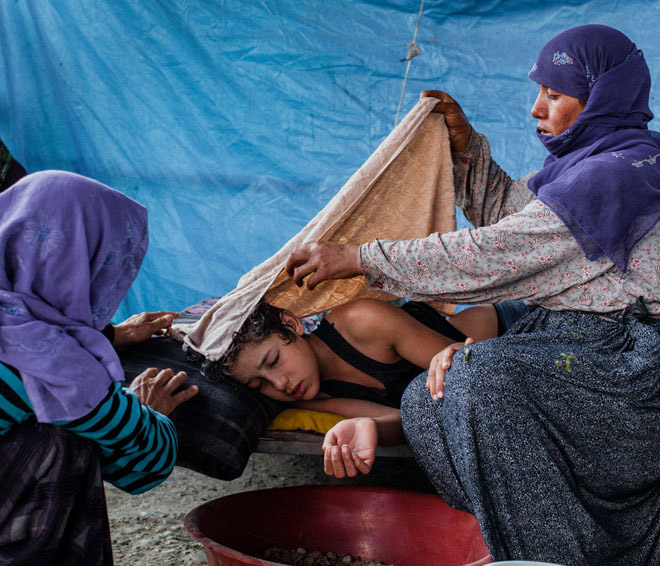The result of two years photographing the often brutal battle against the forces of ISIS in Iraq and Syria, Ivor Prickett’s work, commissioned by the New York Times, is now available as a photo book published by Steidl in Germany.
One of the enduring legacies of the war against ISIS is the missing thousands of people across Iraq and Syria who remain unaccounted for despite the war’s military and territorial victories...
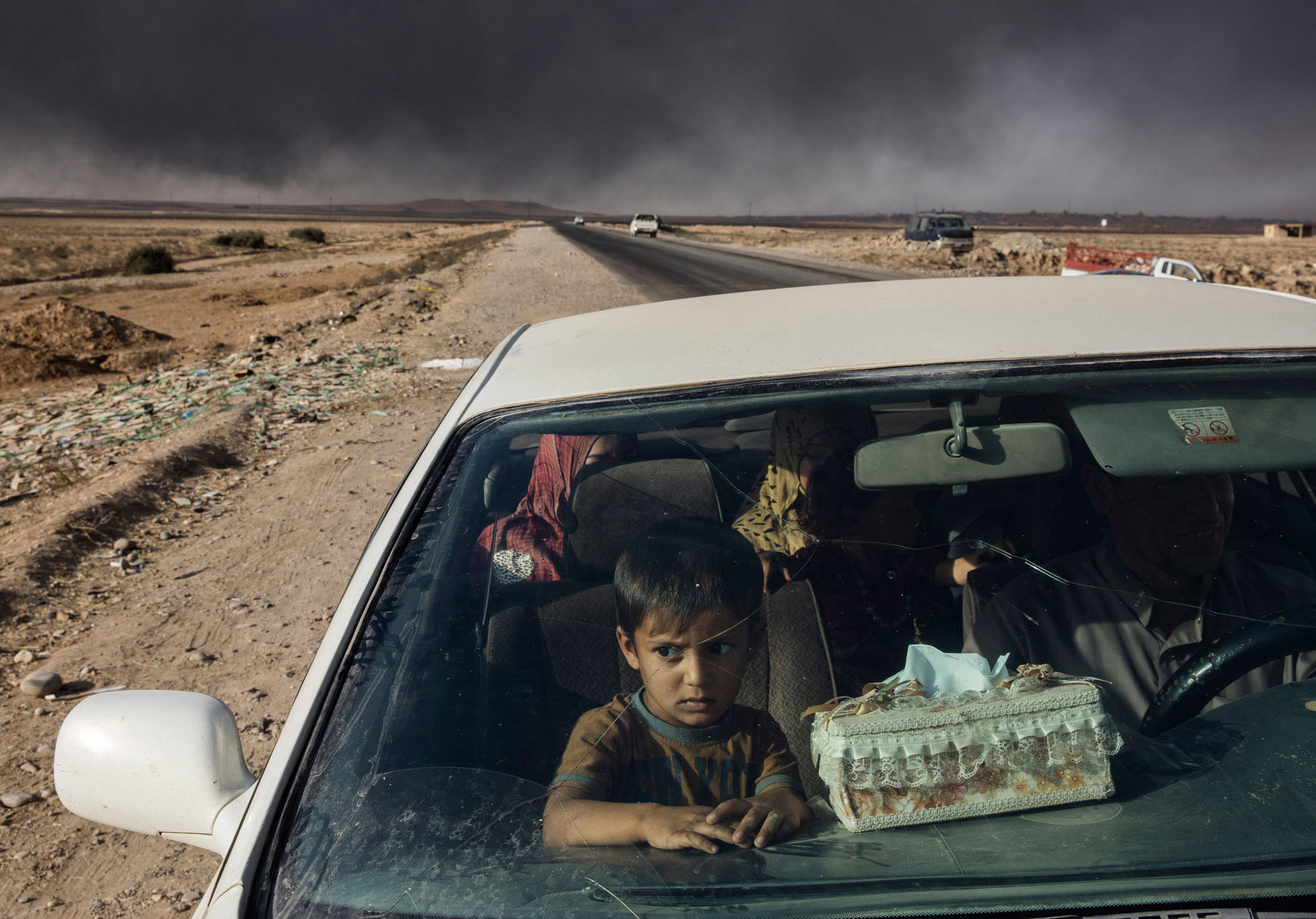
People displaced by fighting in the village of Shora, 25km South of Mosul, reached an Iraqi army checkpoint on the northern outskirts of Qayara. Iraq - October 2016
... both those who were killed by the terror group and are buried in mass graves, and those who perished in the fighting designed to wipe them out.
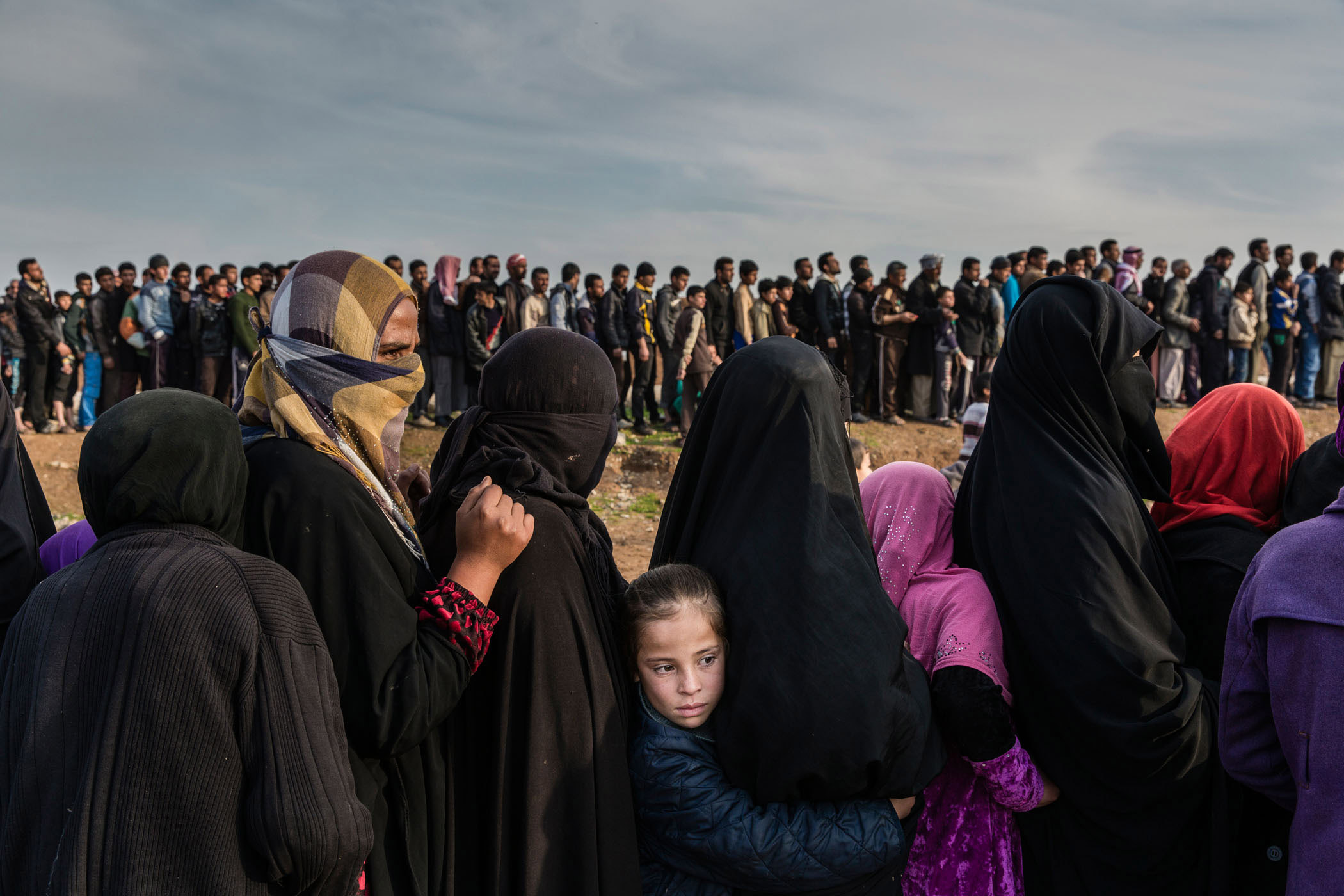
Civilians who had remained in west Mosul during the battle to retake the city, lined up for an aid distribution in the Mamun neighbourhood. Iraq, March 2017
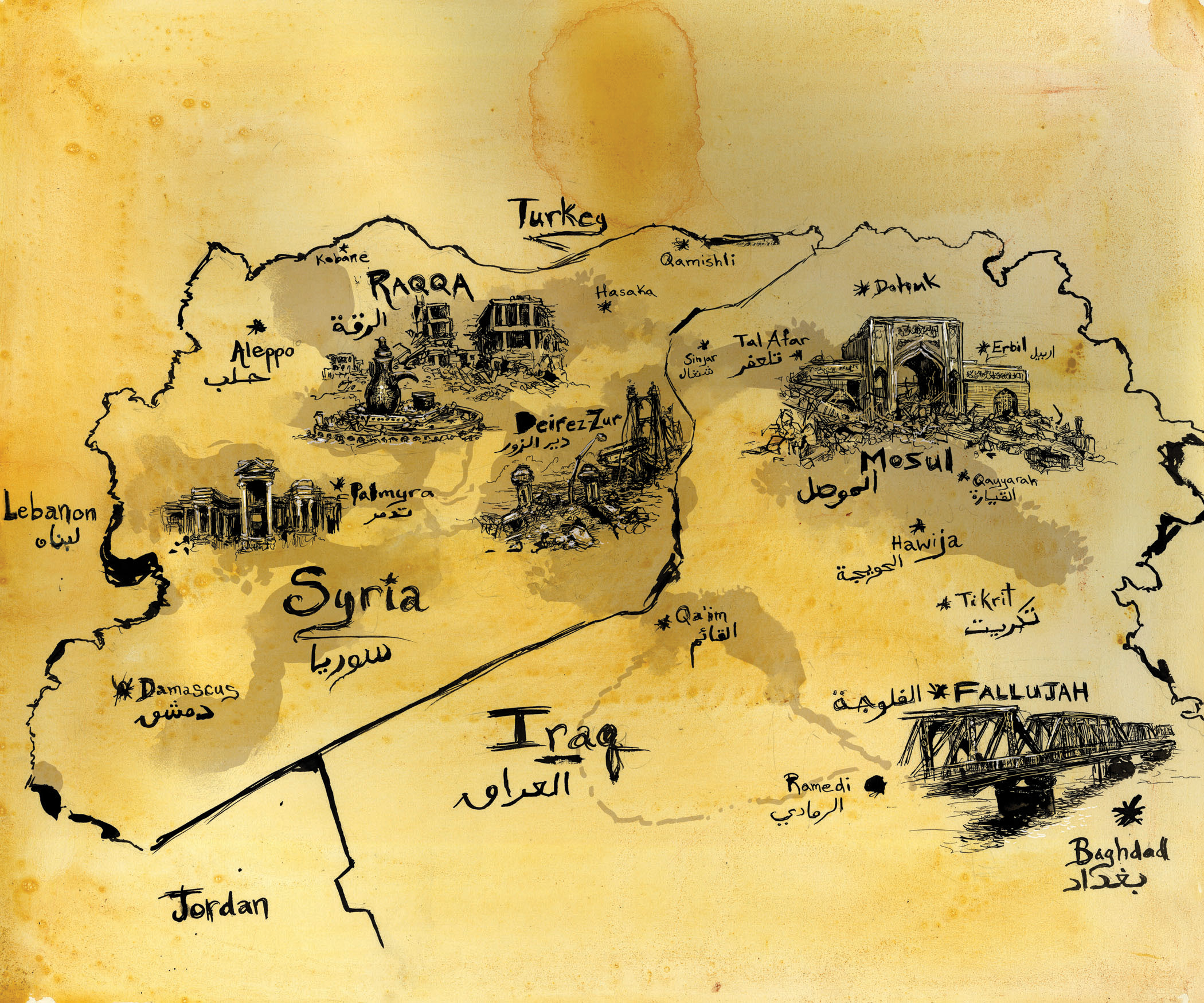
© Molly Crabapple
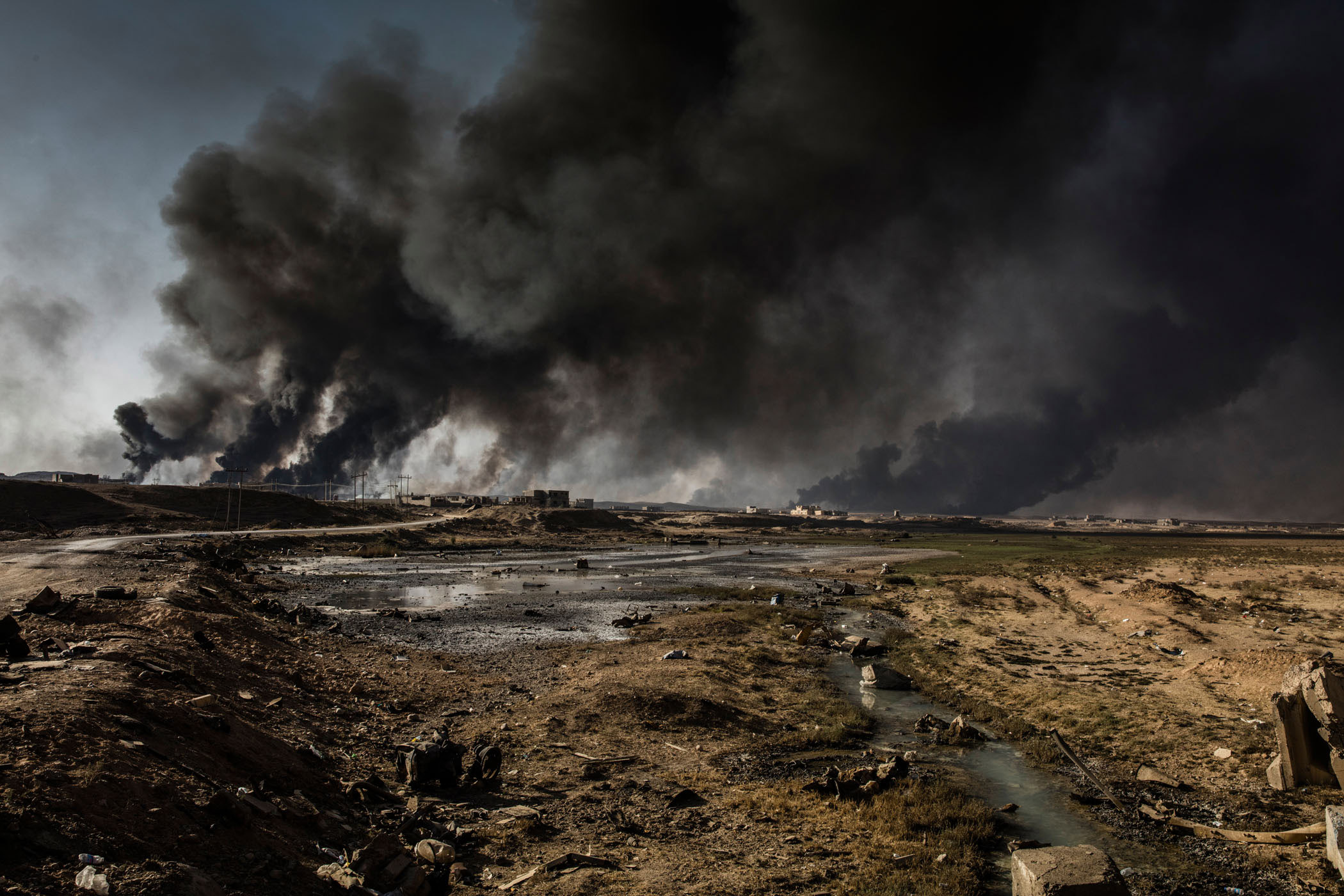
Oil fires, lit by retreating ISIS militants, burned near an Iraqi army checkpoint on the outskirts of Qayara, 75 kilometres south of Mosul. Iraq - October 2016
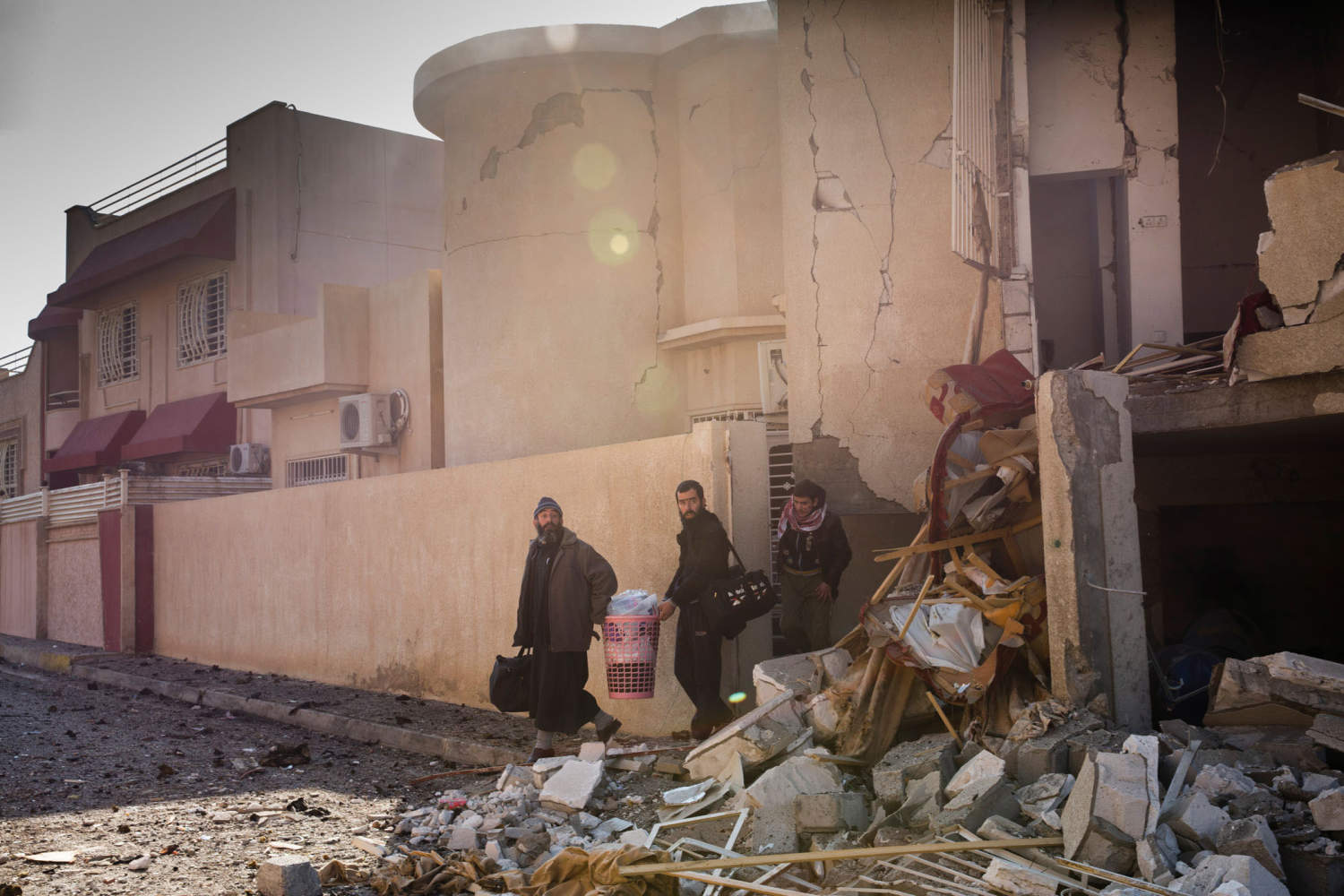
In Mosul alone it is estimated that more than 10,000 civilians were
killed during the operation to liberate the ancient city, home to Iraq’s
most prestigious university and with a pre-war population of over
two million.
Several months after the city had been declared free from ISIS rule,
civil defence workers had the grim job of digging out bodies from the
ruins of the Old City. On a scorching hot day in September 2017, a crew
of workers were searching for the bodies of Nadhira Rasoul’s * sister and
niece. The pair had been killed by an airstrike earlier that summer in
the final stages of the battle for Mosul.
* Mrs Rasoul is named as Mrs Aziz in End of the Caliphate, the book of Ivor’s work in Syria and Iraq published by Steidl
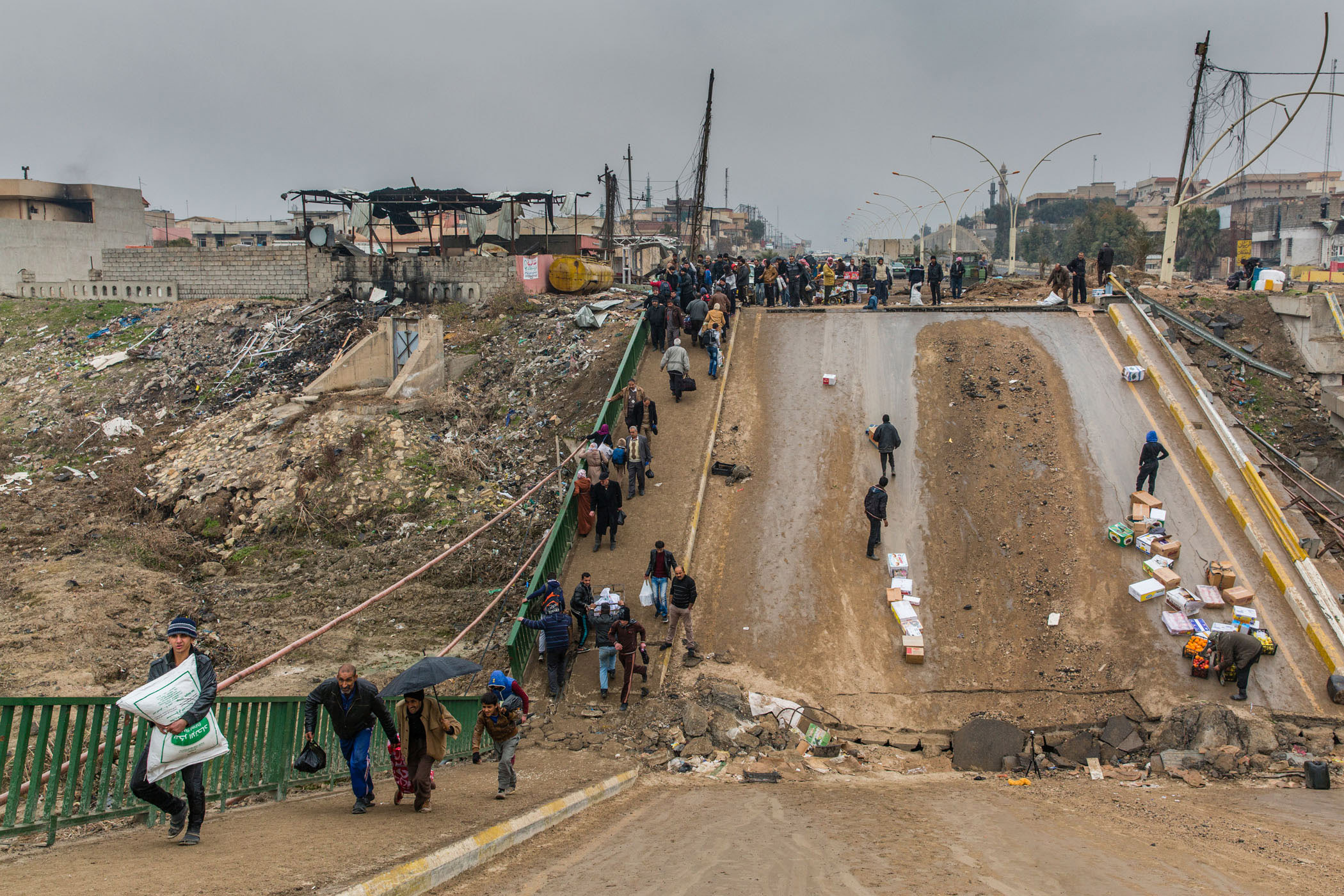
Some people fled the recently liberated Sukar neighbourhood, while others return having crossed a destroyed bridge that connects the area to the rest of the east Mosul. Iraq - January 2017
For me the story began towards the end of 2016, just after the operation for Mosul had started in late October. Initially I found myself documenting the humanitarian crisis that was unfolding as thousands of people fled the city.
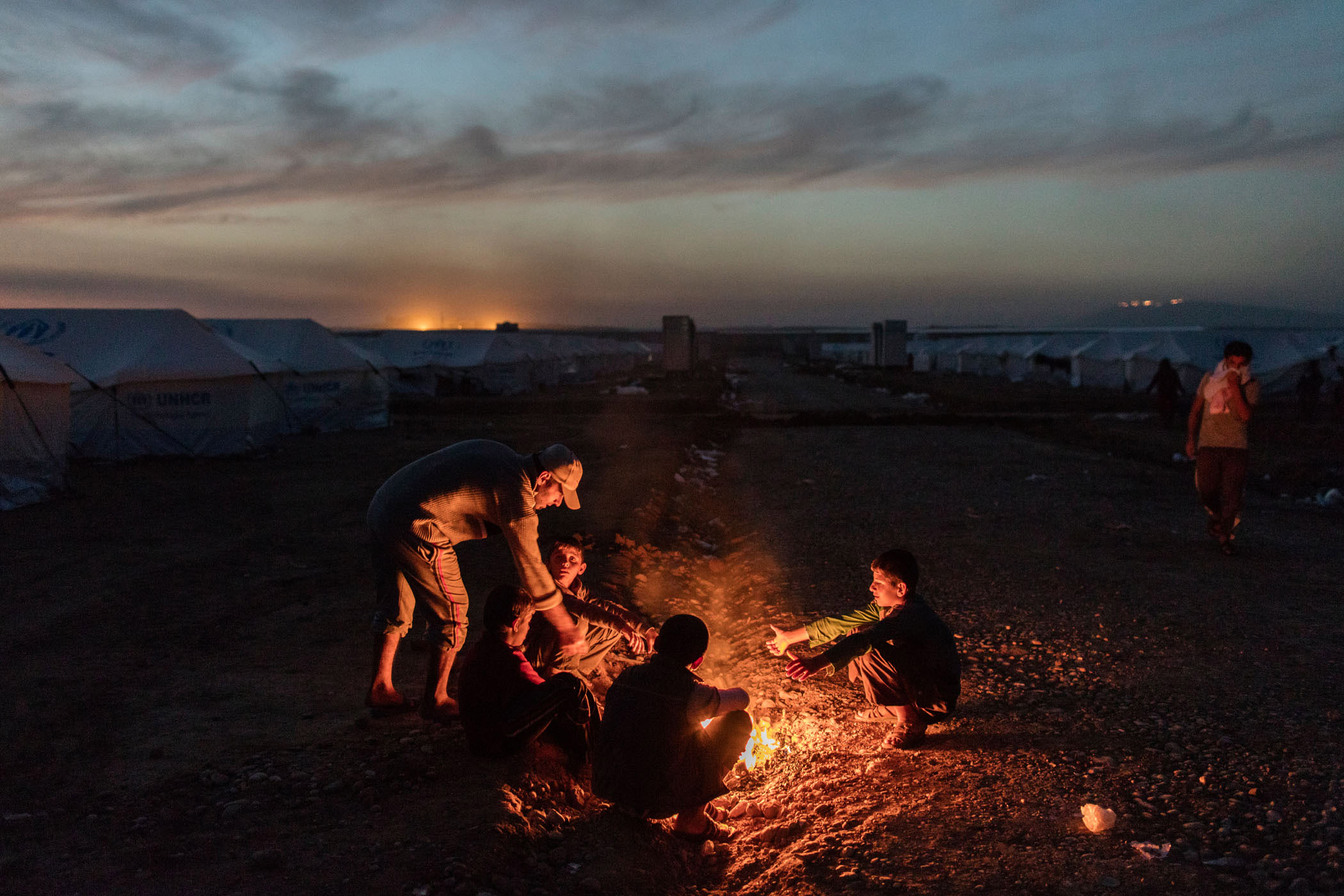
Civilians staying a camp for those displaced from Mosul warm themselves beside a fire. Kurdish controlled Iraq. Iraq - Nov 2016
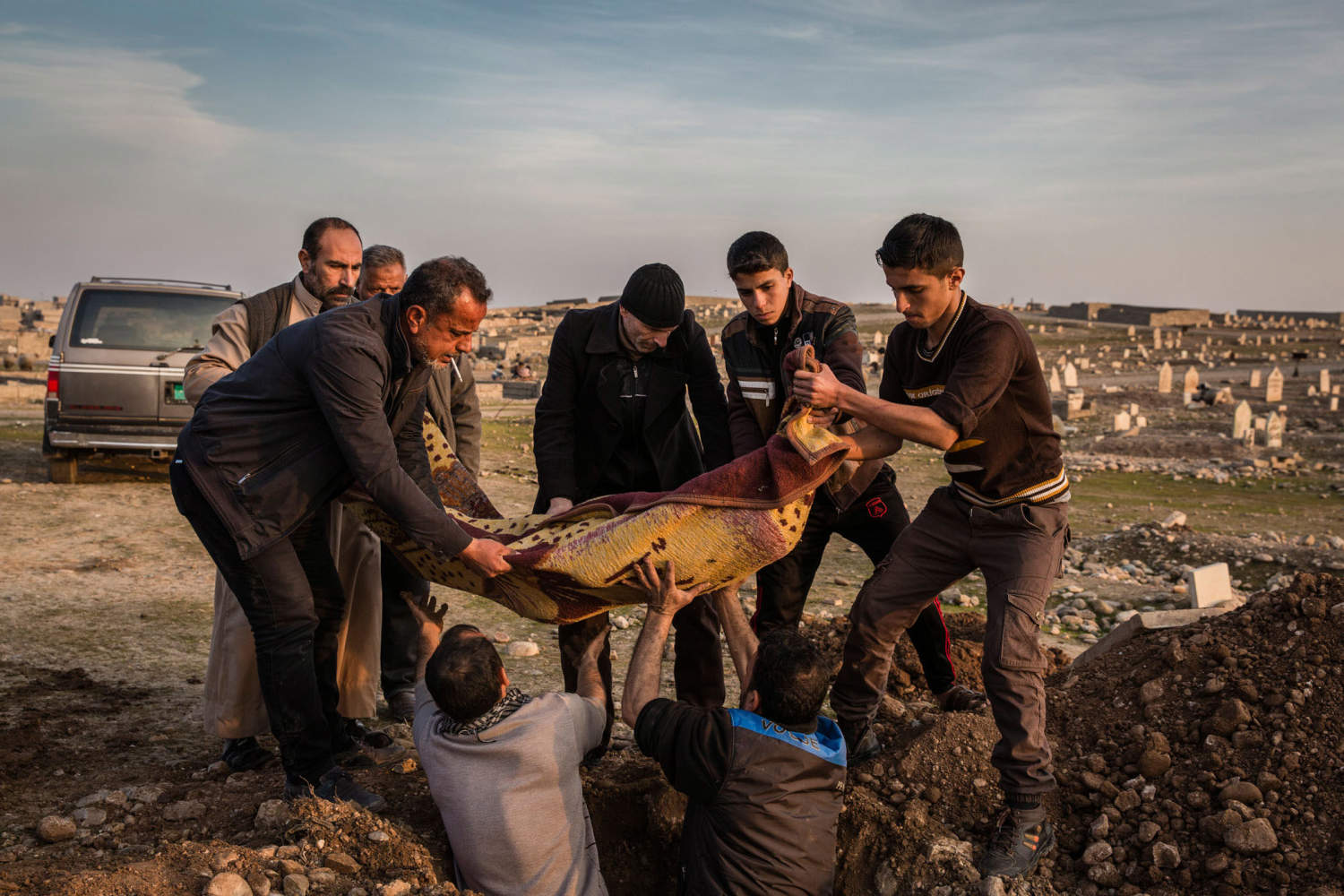
Civilians have always been my interest when covering conflict; I’ve tried to document the savage toll war takes on families caught in its midst.
By early January, reporting exclusively for The New York Times, I found myself probing further into the city on military embeds with Iraqi forces as they battled for control of the eastern side of the city. My focus was still on the civilians who were caught up in the fighting, but in order to really tell that story I knew I needed to be on the frontline.
As the fight drew on, increasingly I started to fi nd myself the only journalist on the ground in many of these situations.
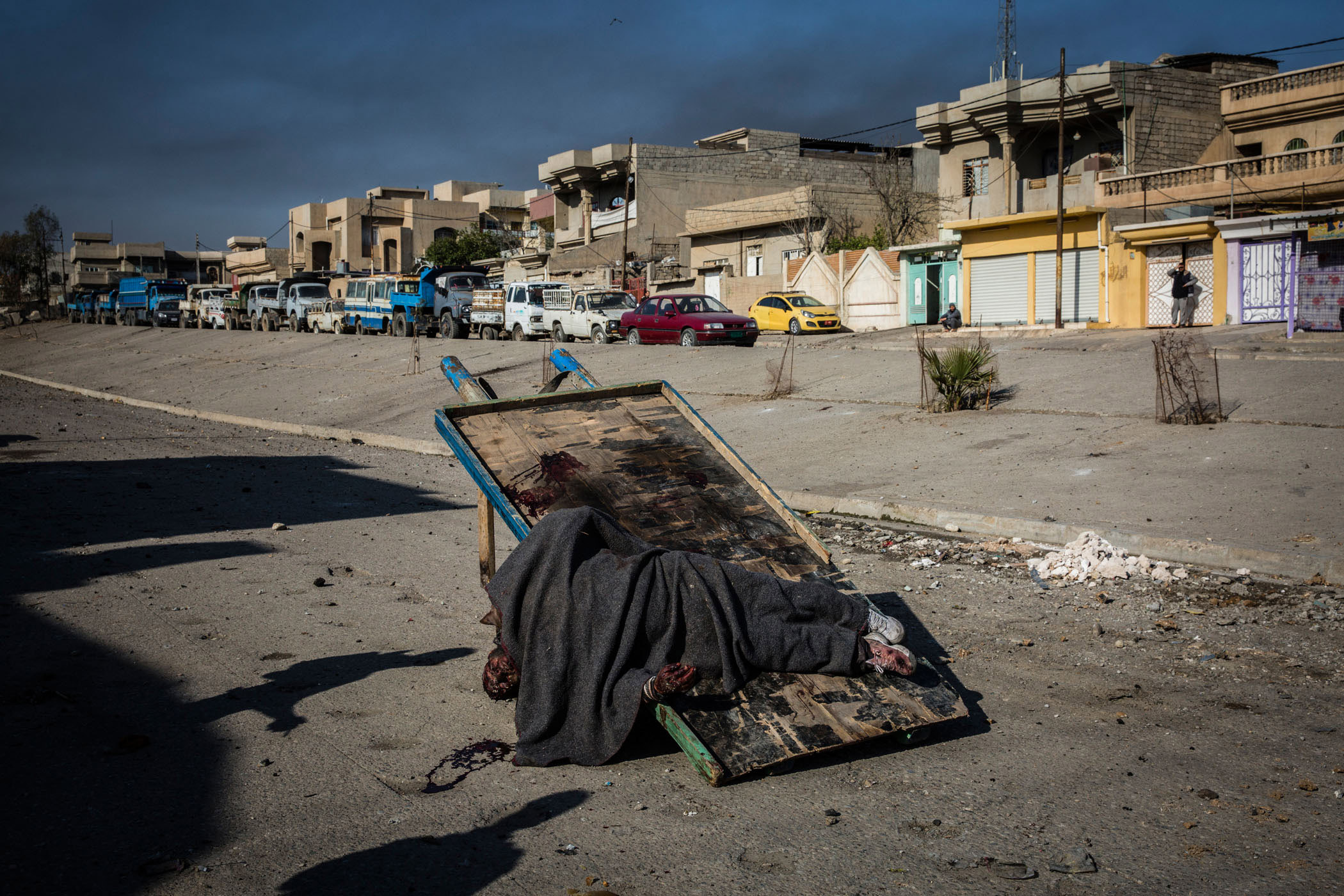
The body of an ISIS fighter lay abandoned on a wooden cart n the Shuhada neighbourhood of west Mosul, the morning after fierce clashes between Iraqi special forces and militants. Iraq - March 2017
Access to the frontline was severely restricted but I was lucky to have the support of The New York Times. Together with the constant help of my editor David Furst, back in New York, and of the local bureau manager in Baghdad, Falih Hassan, we consistently found a way to get in.
Initially I found this solitude disconcerting. Usually when working in such a dangerous environment we tend to stick together as colleagues, and when you look around to see no one else there you wonder if you have pushed to far.
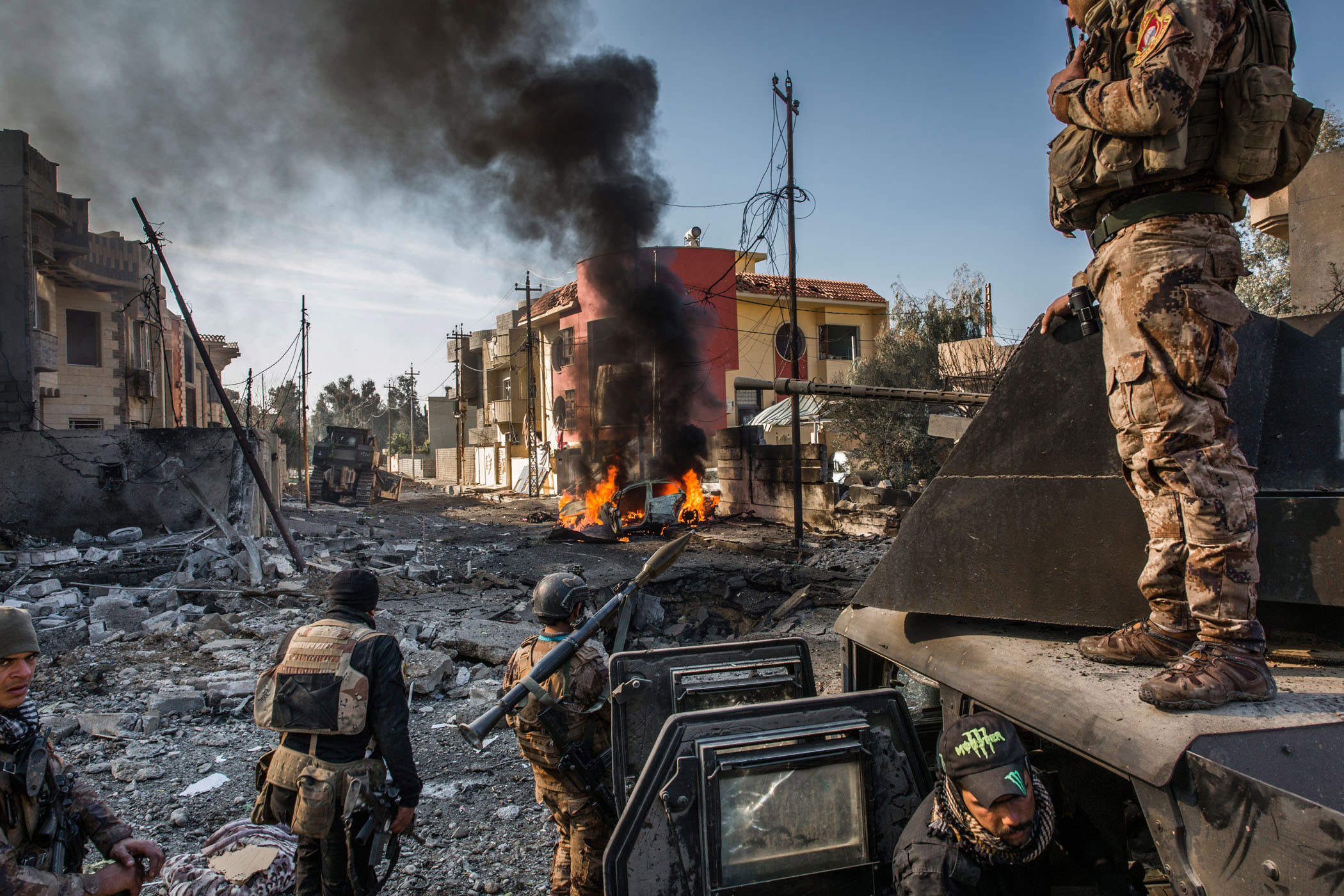
Iraqi special forces soldiers surveyed the aftermath of an ISIS suicide car bomb that managed to reach their lines in the Andalus neighbourhood of east Mosul. Iraq - January 2017
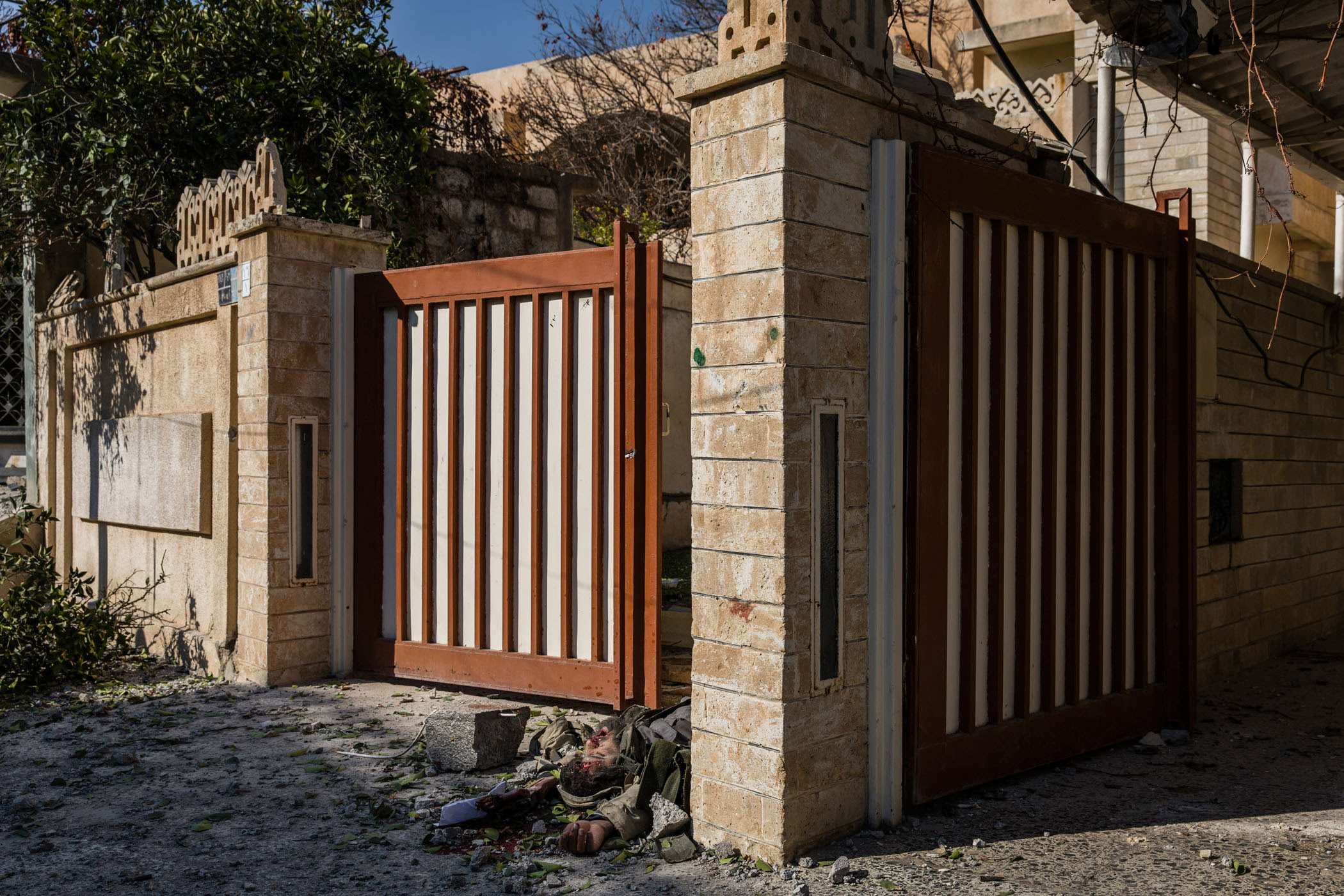
The dead body of an ISIS militant lies in the driveway of a villa in the recently liberated Andalus neighbourhood of east Mosul. Iraq - Jan 2017
Gradually, I realised that this made it even more important for me to be there, as the only outside witness to what people were enduring. I felt the weight of my responsibility as the sole
journalist present.
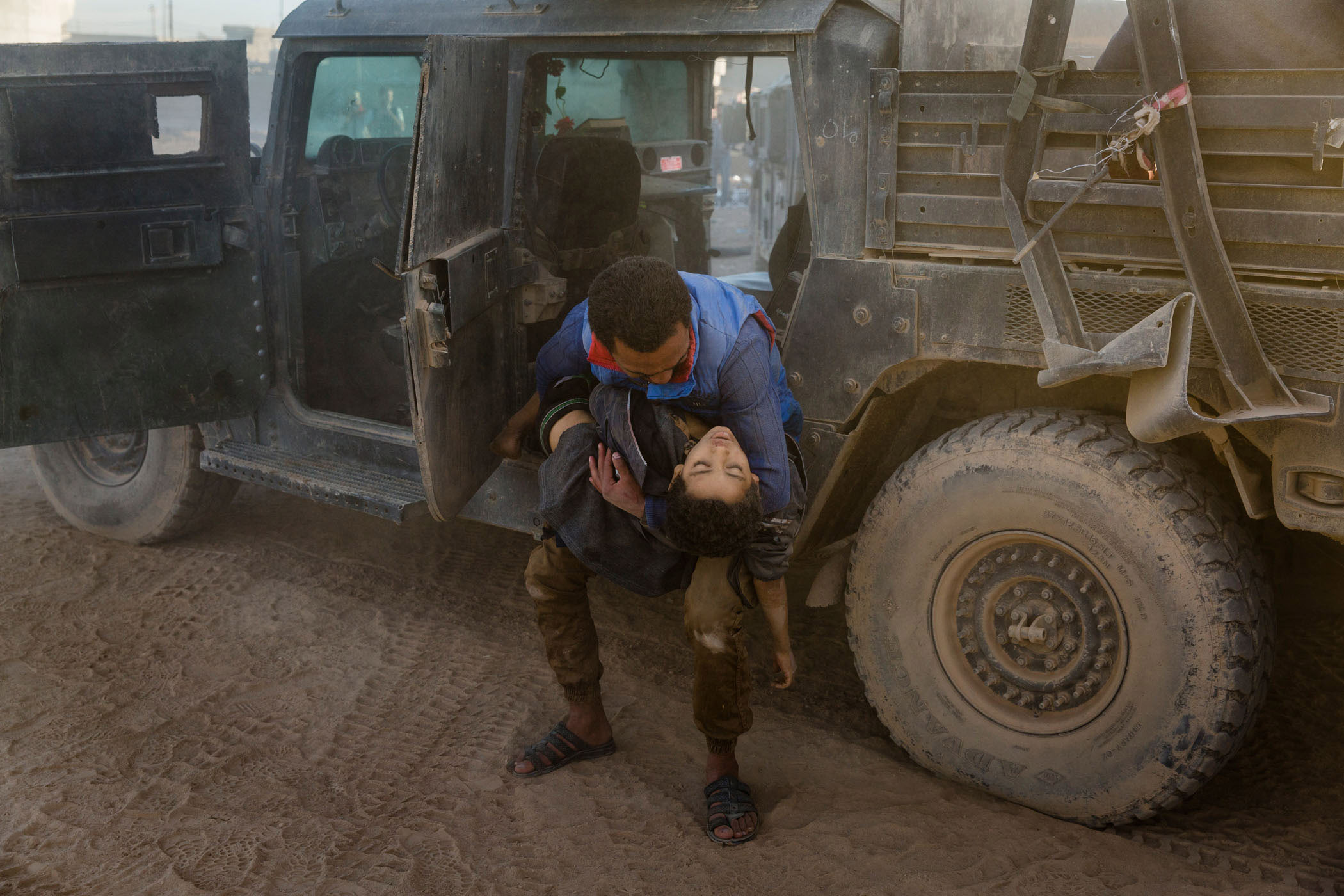
A man collapsed out of an armoured vehicle at a first aid station in east Mosul, holding the body of his younger brother who was killed moments earlier in an ISIS mortar attack. Iraq - November 2016
In July 2017, during the final days of the fight for Mosul, which was played out in the ancient Old City district, a squad of special forces soldiers near the frontline of continued clashes began to shout that they had found an injured militant in the basement of a shattered building. A few of the men hauled the emaciated fighter out of the basement into the street. He was barely alive, injured during a battle several days before.
He said that his name was Malik, and that he was a 36-year-old resident of Mosul. He was so weak it was hard to imagine him being a capable fi ghter at any point recently. The commander ordered him to be taken to a doctor, and the men carried him away across the mounds of rubble and around the corner, out of sight.
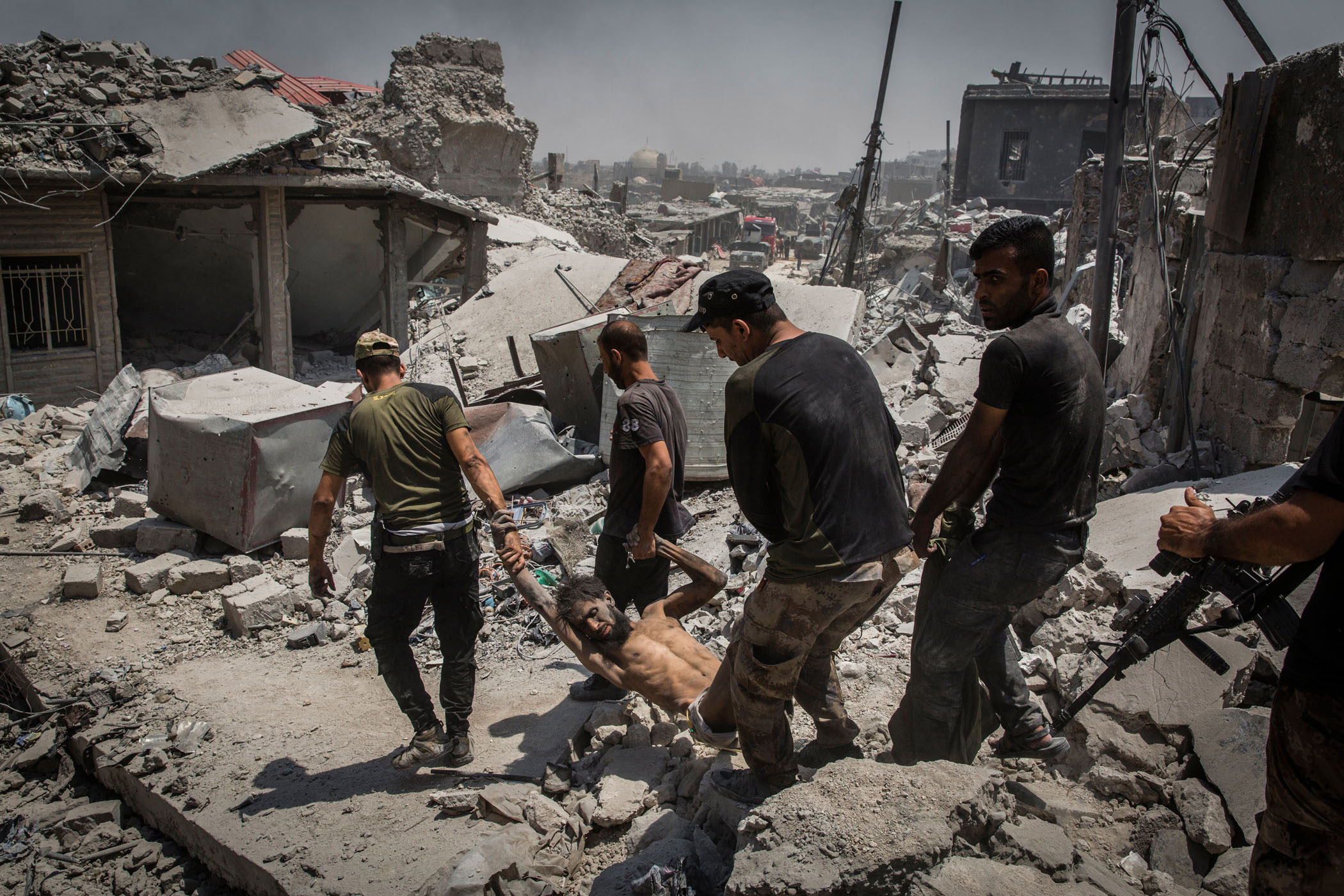
Iraqi special forces soldiers carried away an injured ISIS fighter who had surrendered, moments after they dragged him out of the basement of a destroyed building in the Maydan area of Mosul’s Old City. Iraq - July 2017
On several occasions the soldiers tried to stop me taking pictures of them carrying the prisoner away. I had to fight to maintain my right to document what was going on and ultimately was allowed to take one last picture as they carried him away across the rubble.
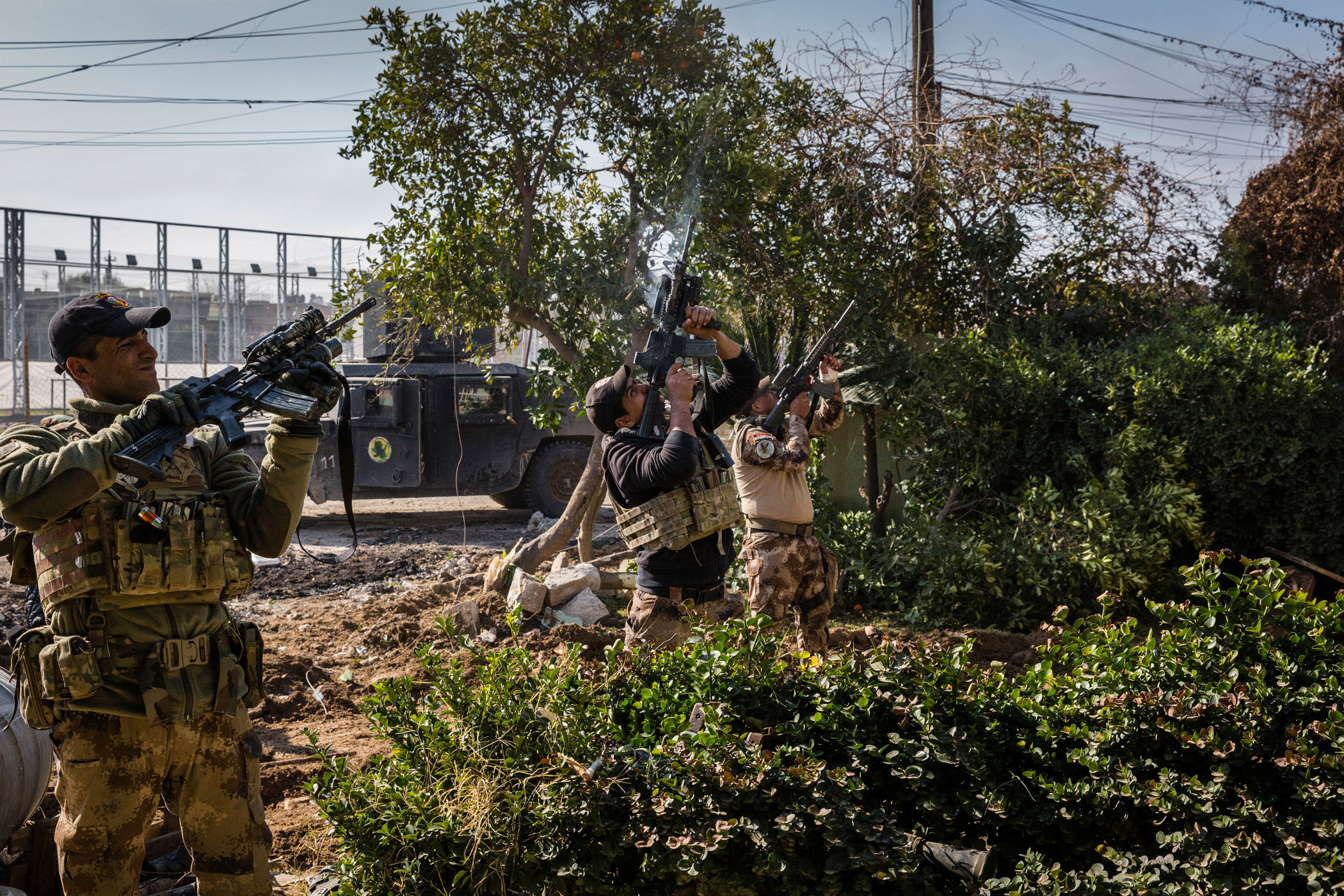
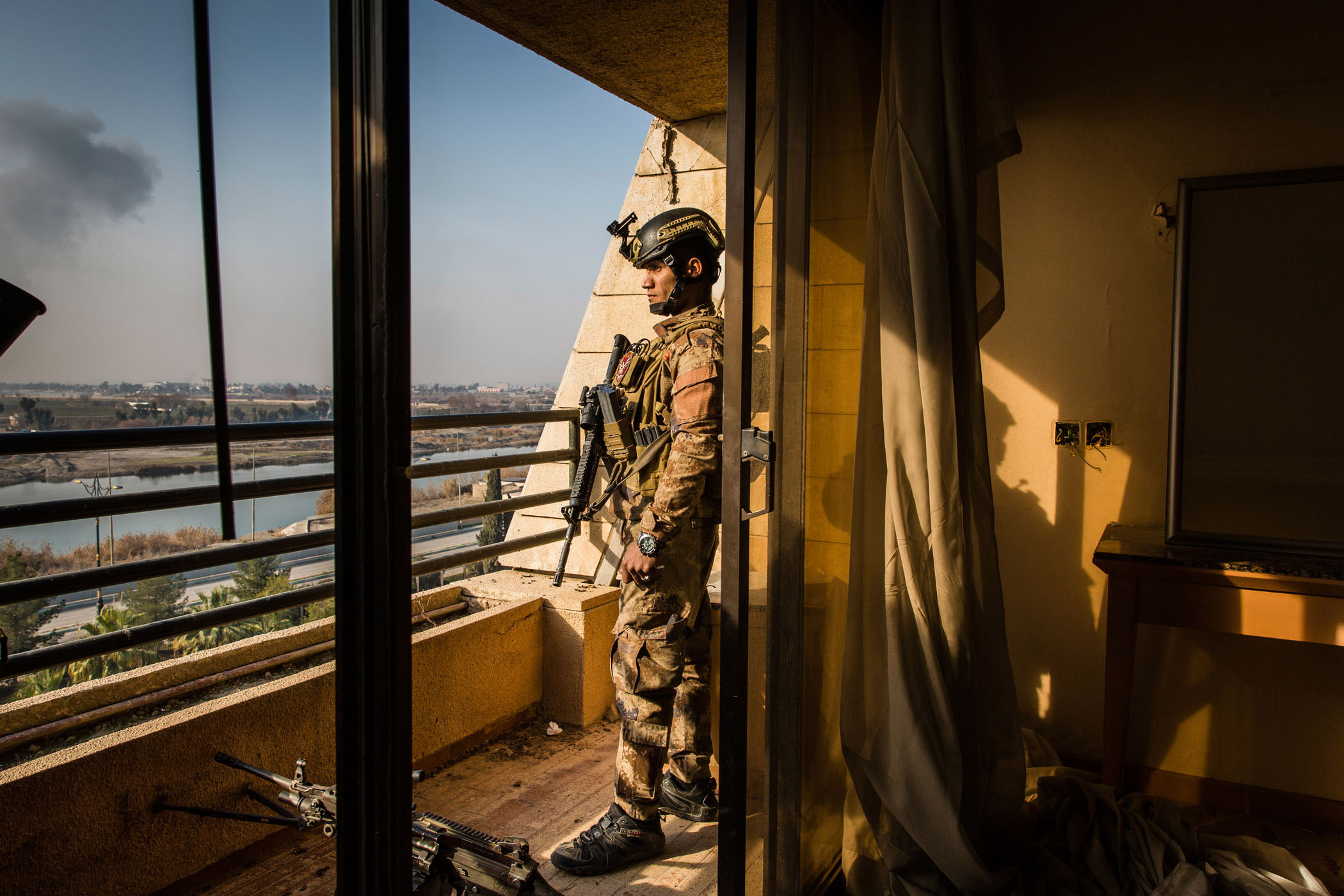
They were probably the last moments of Malik’s life; most ISIS fighters who were captured alive at that stage in the conflict were killed on the spot.
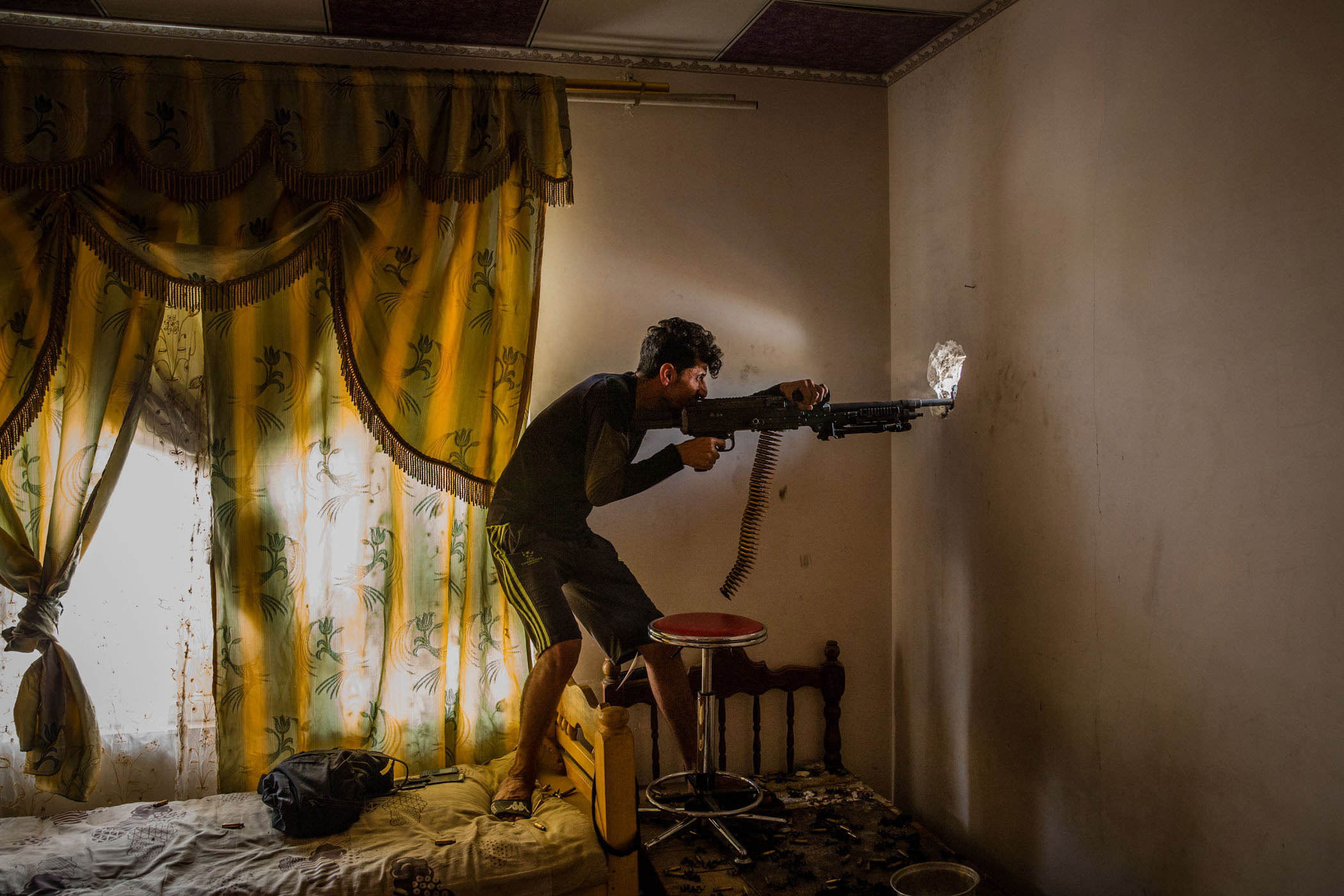
An Iraqi special forces soldier fired on ISIS militants from a defensive position on the edge of the Rifai neighbourhood of west Mosul. Iraq - May 2017
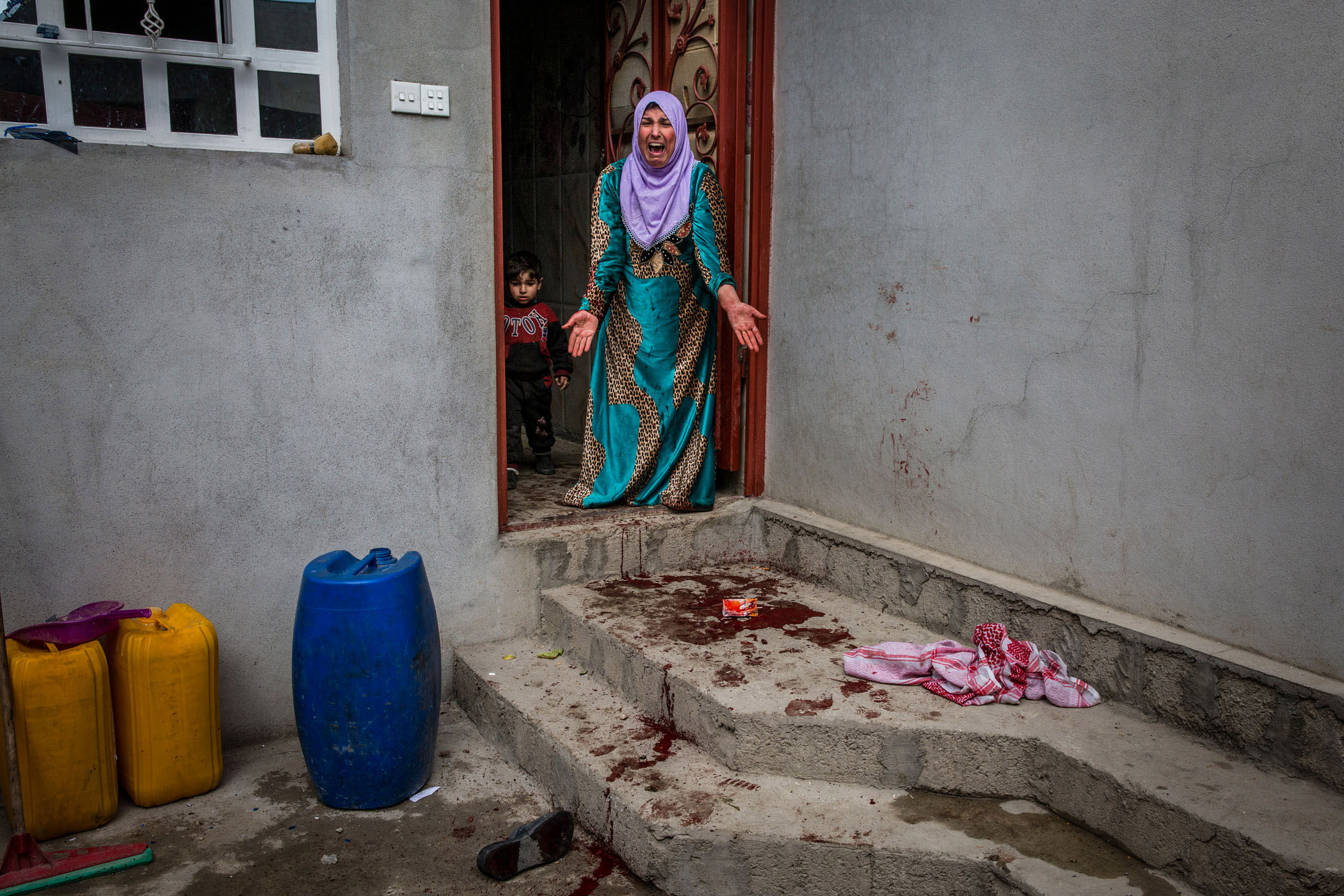
A woman screamed out in horror shortly after her son was killed in an ISIS mortar attack in the Jadidah neighbourhood of west Mosul. Iraq - March 2017
It was a surreal moment for me to realise that I could have empathy for a man who I knew was involved in the mass destruction and killing that I had been witnessing for the previous eight months.
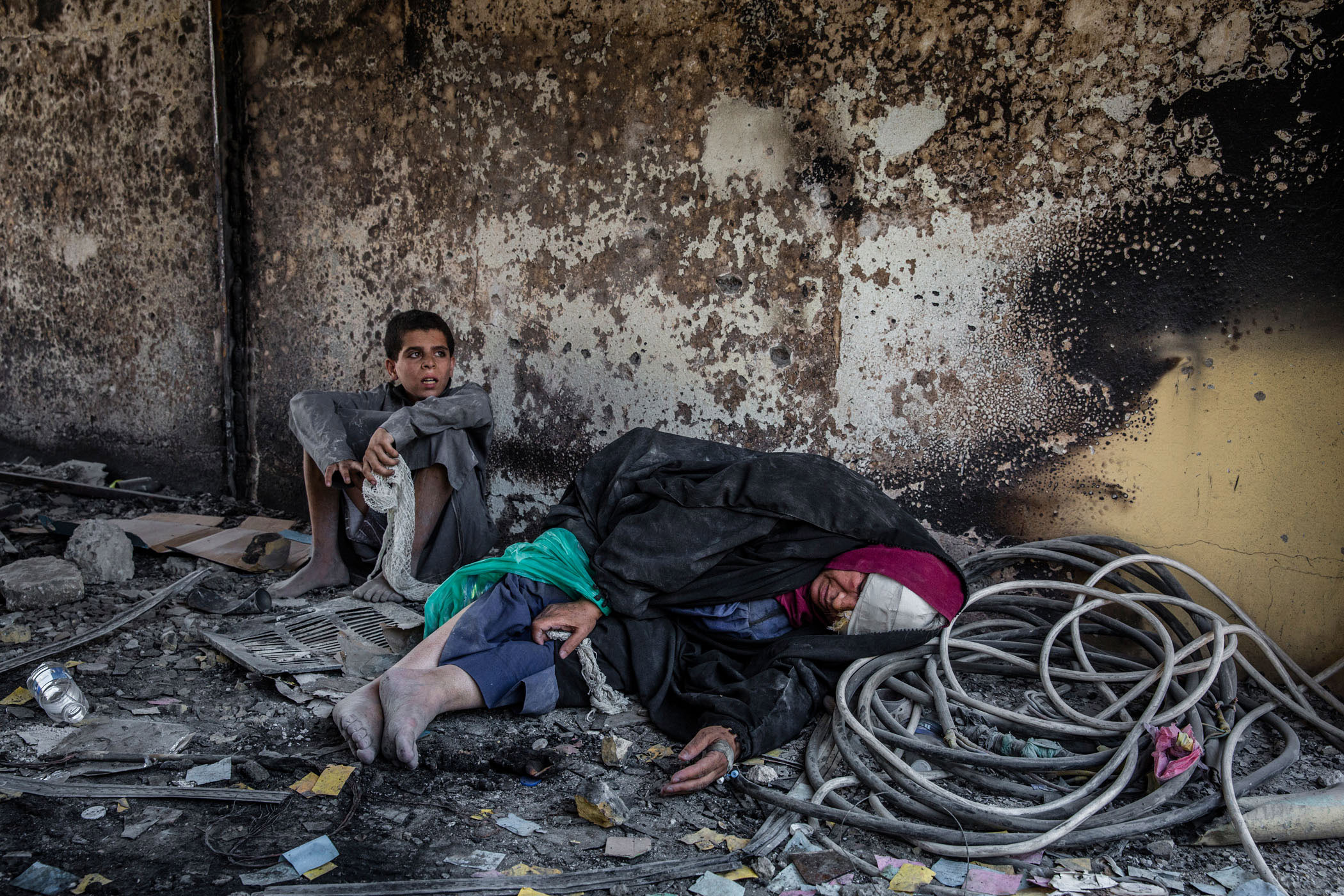
A woman and young boy collapsed from fatigue after fleeing the last area of Mosul’s Old City still controlled by ISIS. Iraq - July 2017
At the time I couldn’t quite reconcile this or understand why I thought it was important for me to take these pictures.
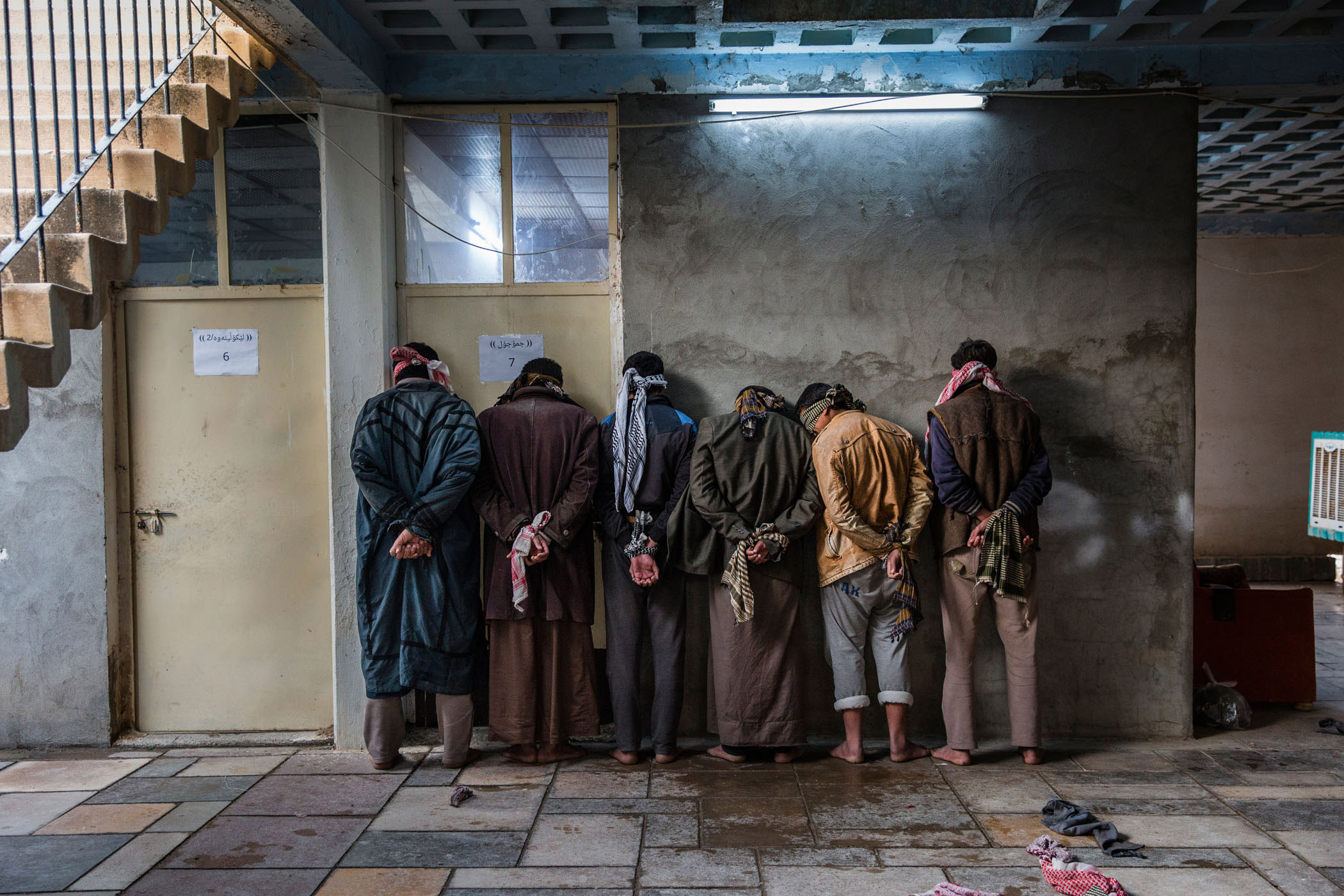
Iraqi men who had fled ISIS controlled areas in Hawija, waited to be questioned about possible links to the terror group by Kurdish security personnel at a base near Kirkuk. Iraq - December 2016
In hindsight, I think it is because I knew this wasn’t the answer. That more killing didn’t bring an end to anything, but rather the wholesale destruction of Mosul’s Old City and the deaths of thousands of people who were cornered there would just seed a new generation of revenge.
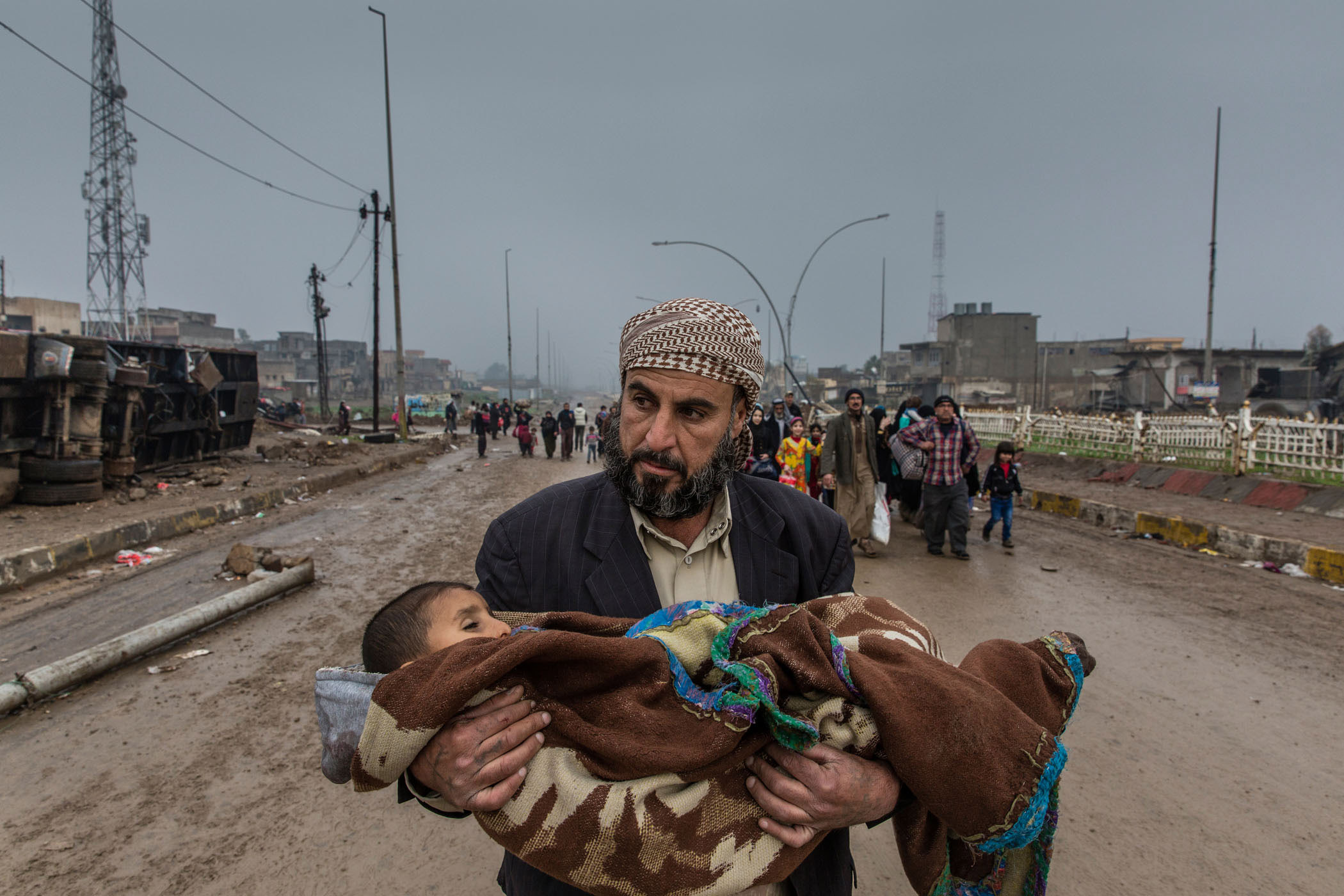
A father carried the body of his 5-year-old son through the Mamun neighbourhood of west Mosul as he flees the city. The boy was reportedly shot in the throat by an ISIS sniper in the Resala neighbourhood of the city. Iraq - March 2017
As I write this in November 2018, I am still unable to track down the subject of one of my most enduring images. It was during the final days of fighting in the Old City of Mosul that I witnessed the soldiers bring in a man who had crossed the frontline, holding a young boy no more than two years old.
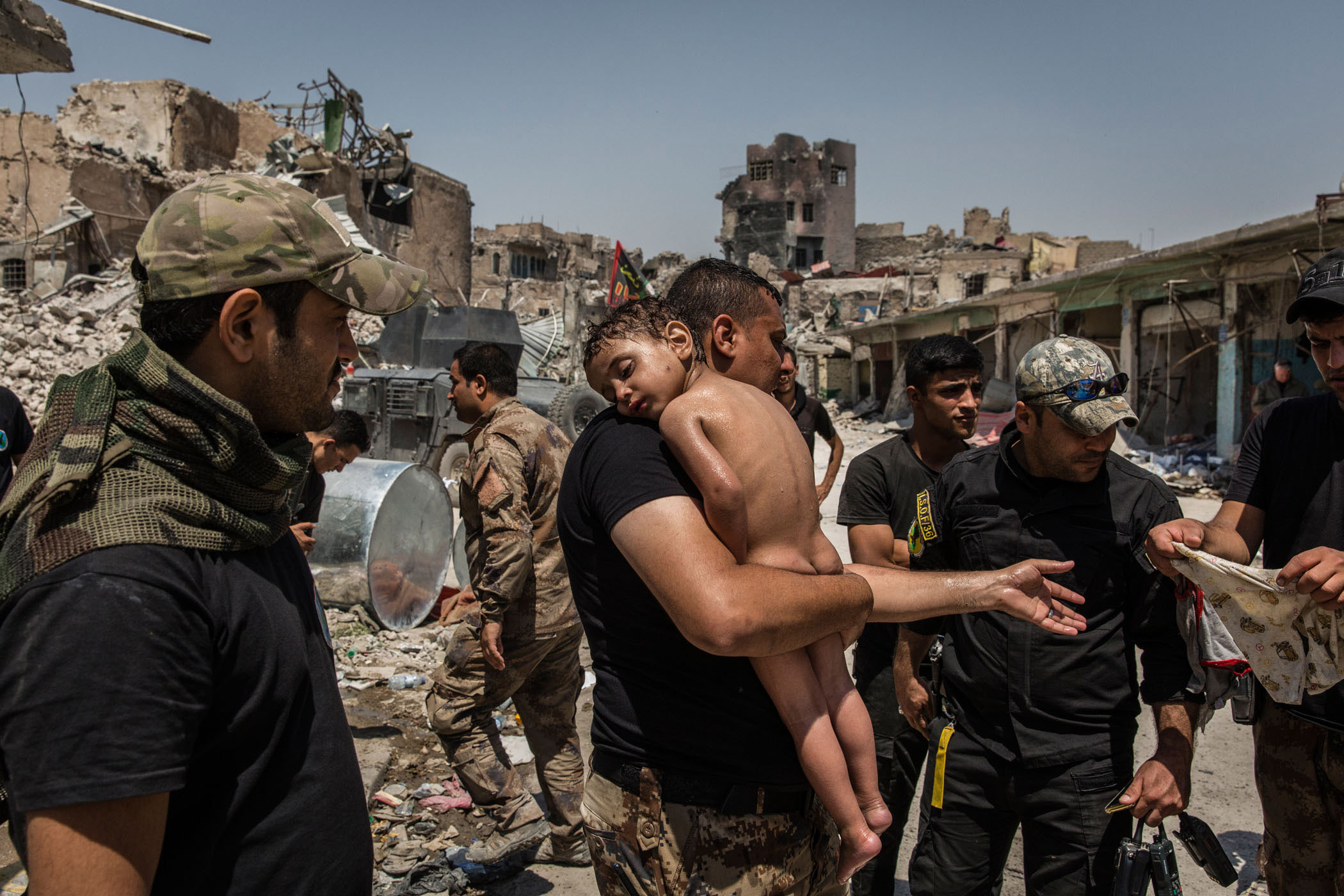
An unidentified young boy who was carried out of the last ISIS controlled area in the Old City, by a man suspected of being a militant, was cared for by Iraqi Special Forces soldiers. Iraq - July 2017
Suspecting that he was an ISIS fighter who had simply used the boy as a human-shield, the troops took the man away, and the commander in charge held the boy on his lap.
Doubting that the boy’s parents could still be alive, he decided that one of his men should adopt the boy. Here on the battlefield, some of the men washed the child and his tattered clothing before the officer arrived to meet his new son.
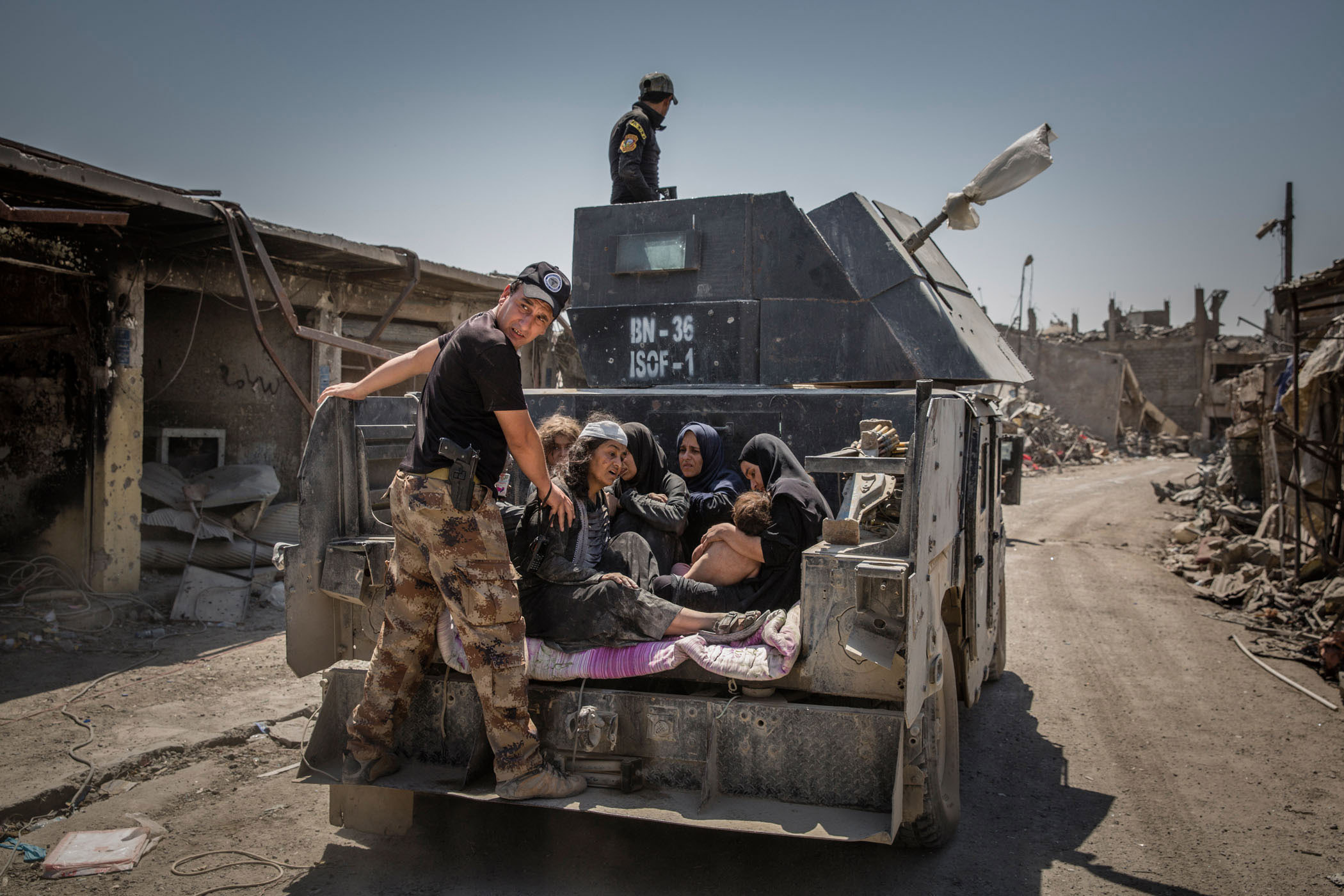
A shellshocked group of women and children were transported to a displaced persons camp shortly after they had fled the last area under ISIS control in Mosul’s Old City. Iraq - July 2017
It was a surreal scene to watch, as the battle-hardened men, expert killers, put down their weapons and cared for the young, fragile boy. It was as if for a moment, this child made these men forget the lives they had taken and the friends they had lost over the past eight months.
Or, maybe, he made them remember.
The picture immediately affected people and I was flooded with questions about his wellbeing. His naked fragility against the backdrop of a concrete war zone appeared to symbolise the devastating toll that war has on civilians, in particular children.
At the same time it was a moment of caring and salvation, in contrast to the level of violence and revenge killing that was going on at that time. In a way this troubled me because this symbolism was somewhat misleading or contrary to how I felt the war was being carried out at that point.
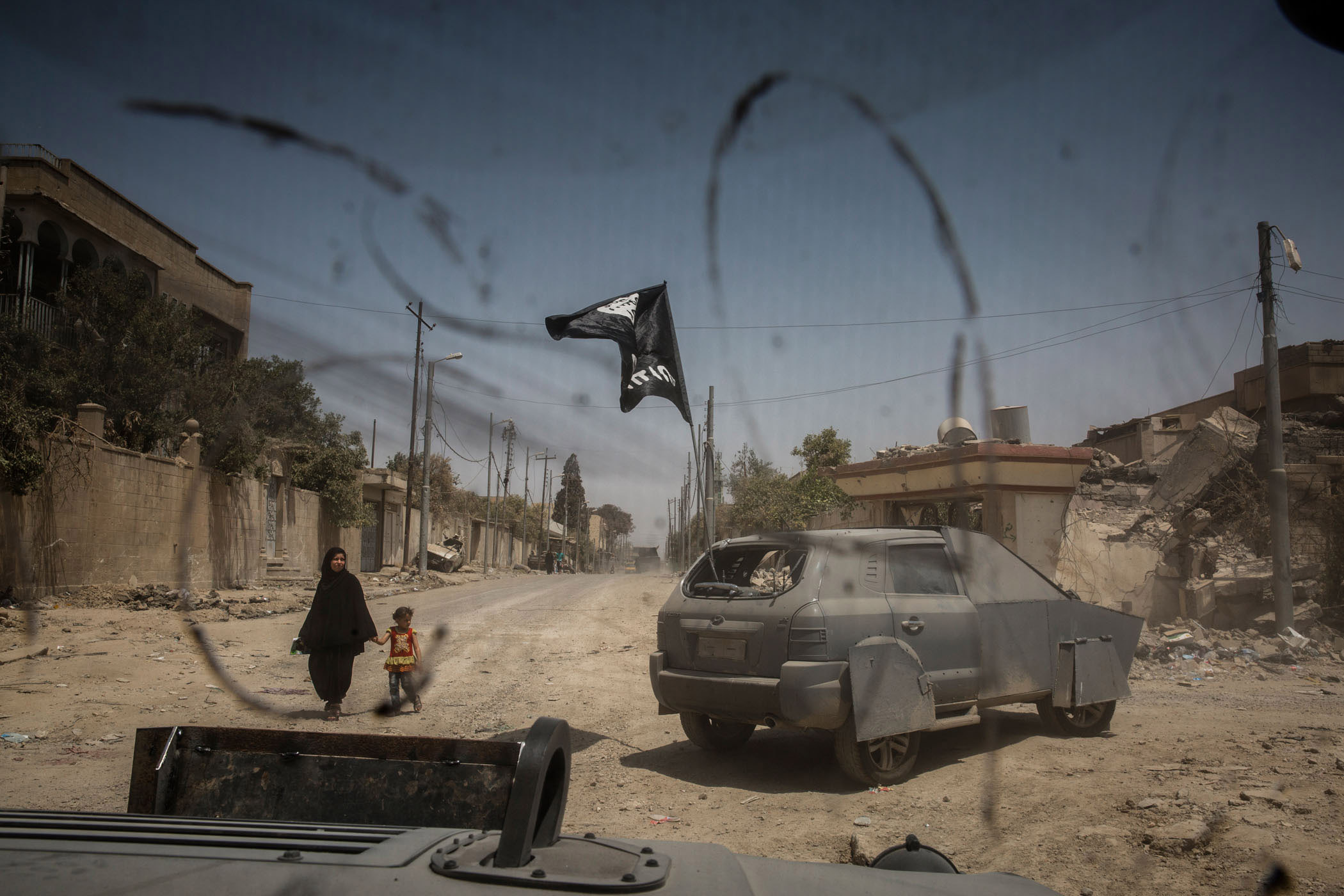
Iraqi Special Forces soldiers drove an armoured car bomb made by ISIS that they found in the Old City back to their base in Mosul. Iraq - July 2017
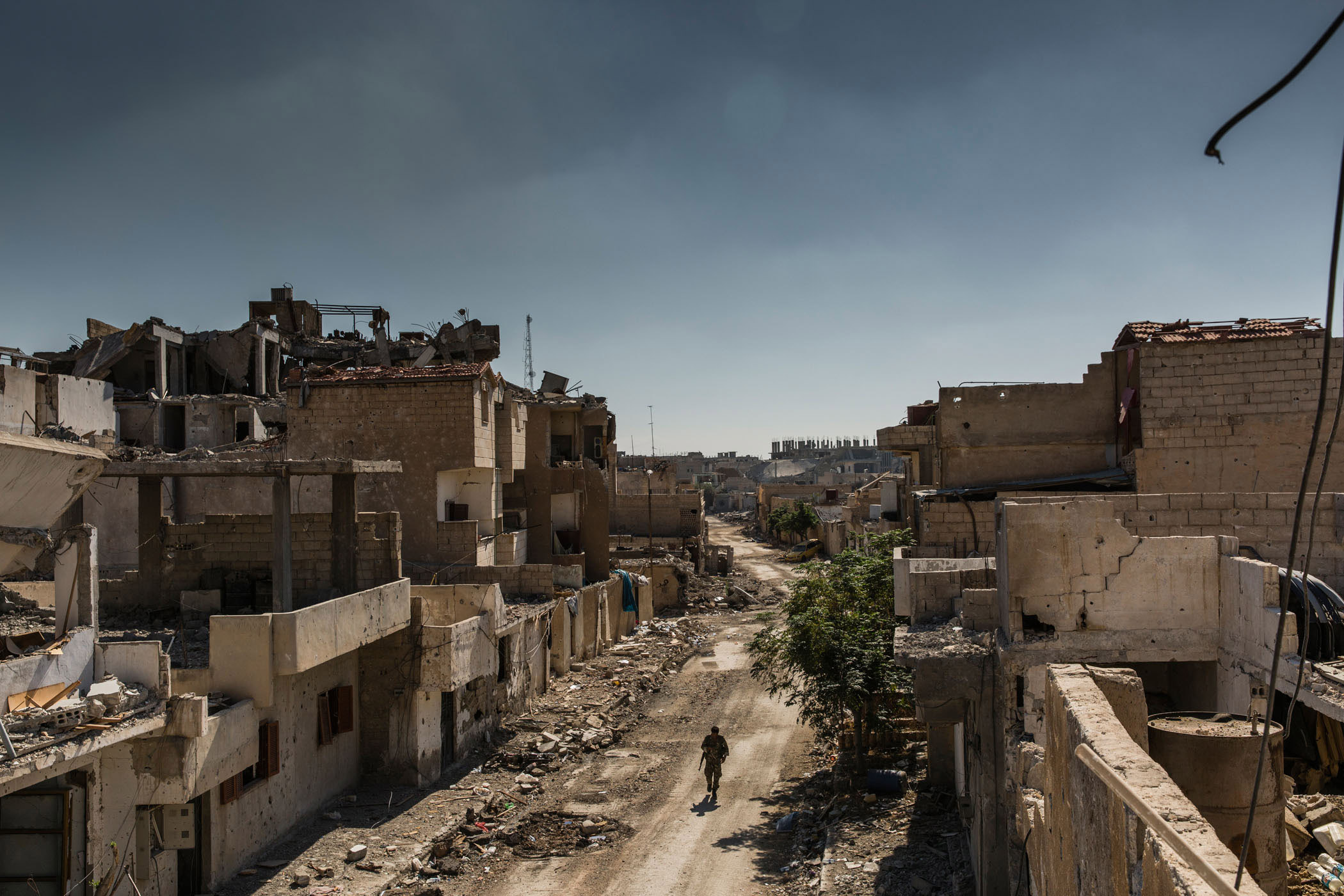
An SDF (Syrian Democratic Front) soldier walked through the destroyed streets of east Raqqa, near the end of the battle to retake the city from ISIS. Syria - October 2017
The truth is, it was all of these things and that is what war is like, a kaleidoscope of the highs and lows that humanity is capable of. It raised the question of whether it was right for the boy to be adopted in such a way, without any official process. Part of me felt he was lucky to have met this fate in a such a hard-knock country.
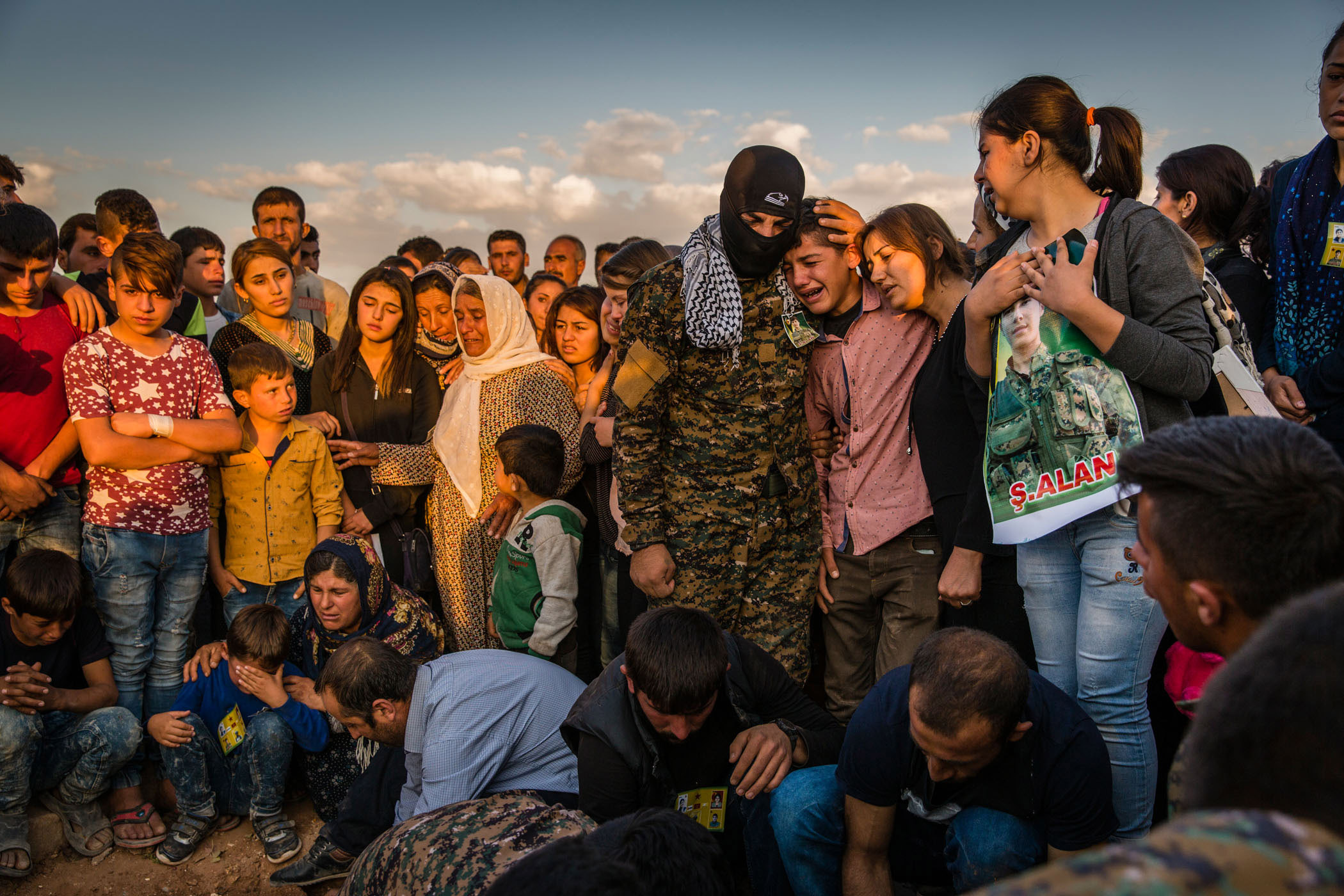
SDF comrades and family members mourned during the burial of Adhem Sheko, who was killed fighting in Raqqa, at the martyrs cemetery in Kobane. Syria - October 2017
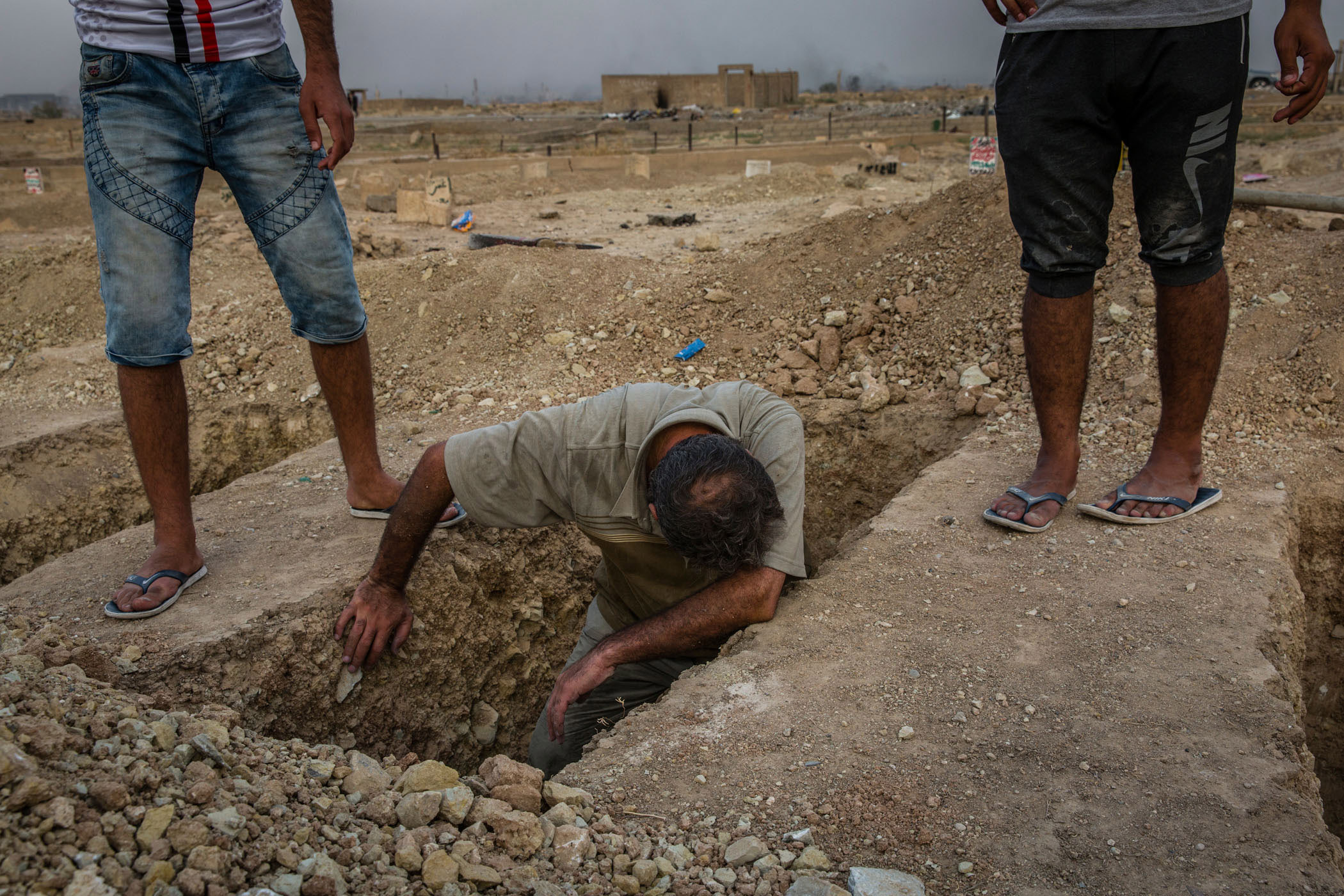
Fouad Mohammed Sadi wept as he helped to lower the bodies of his wife, daughter and two brothers into the ground. They were all killed in separate air and artillery strikes during the final stages of the fight for Mosul and their bodies had remained buried under the rubble for months afterwards. Iraq - September 2017
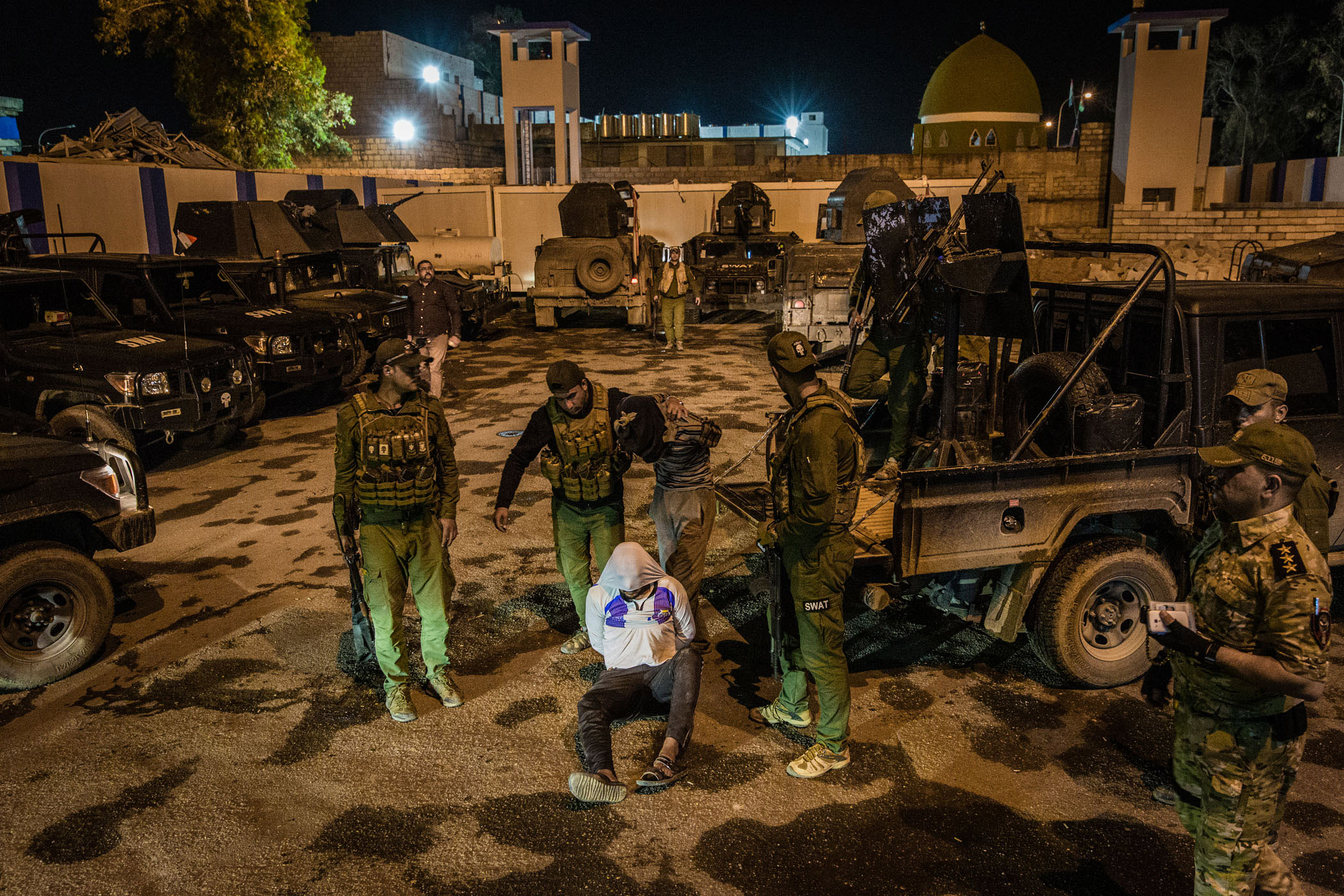
Suspected ISIS members who were detained by Mosul Swat forces in a series of late night raids were unloaded back at the unit’s base in east Mosul. Iraq - May 2018
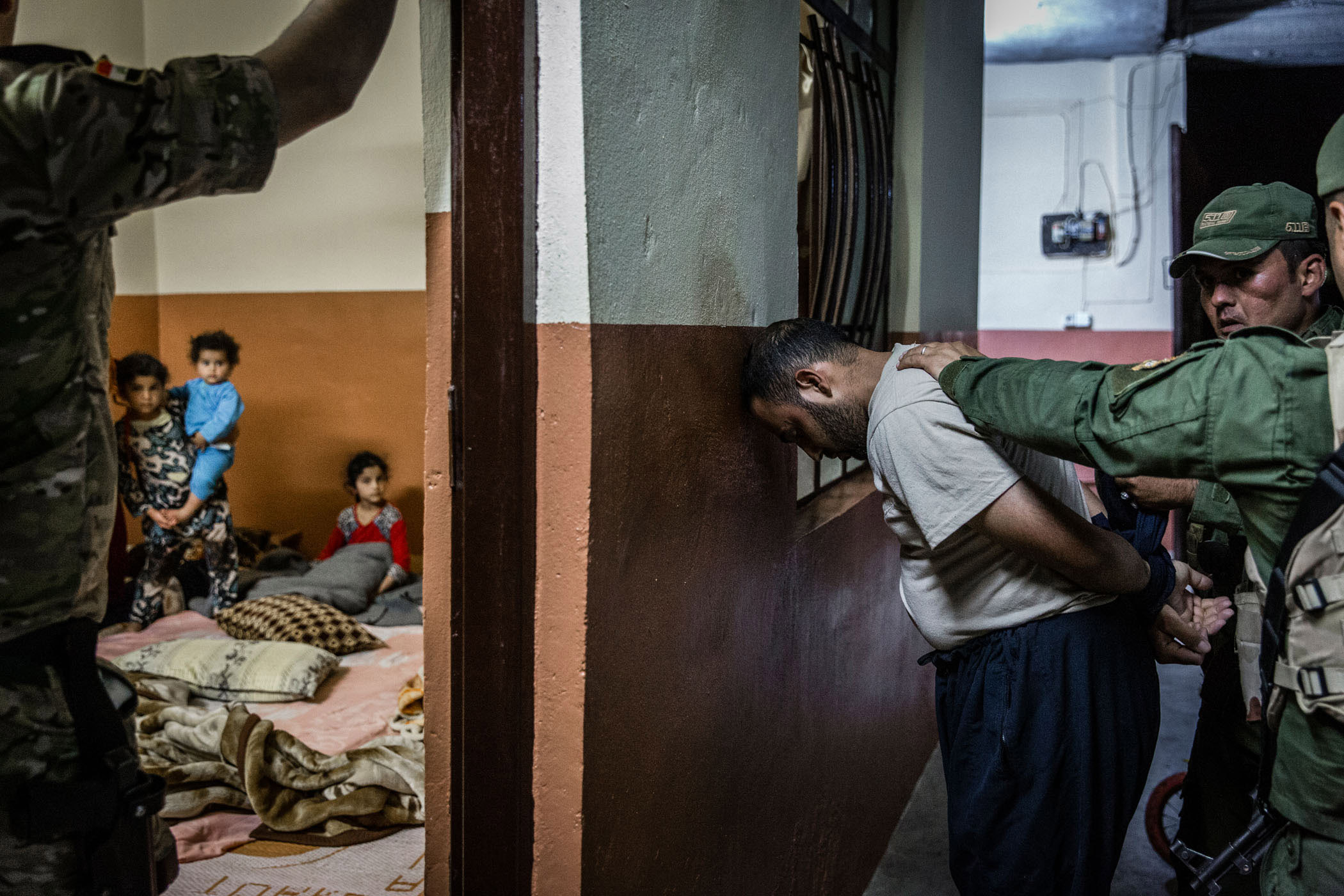
Mosul Swat troops detained a man identified as being a member of ISIS while his wife and children huddled in the room where they had been sleeping in the village of Badush, northwest of Mosul. Iraq - May 2018
Months later I tried to track him down. Some of the men from the unit I was with that day said that he had in fact been reunited with his mother who was found to be still alive. There was no way to find them because no one knew their names. They said that she was from Syria and had been married to four different ISIS men, which if true would mean she and her boy were probably taken into custody and were now lost
in the Iraqi judicial system. I was left unsure if this was even true and if the men were either mistaken or were covering for the man who had in fact adopted the boy, for fear of him being taken away. I still hold out hope I will manage to track him down some day. If I do, I hope to find he was given the chance to have a better life than the first years of his short existence.
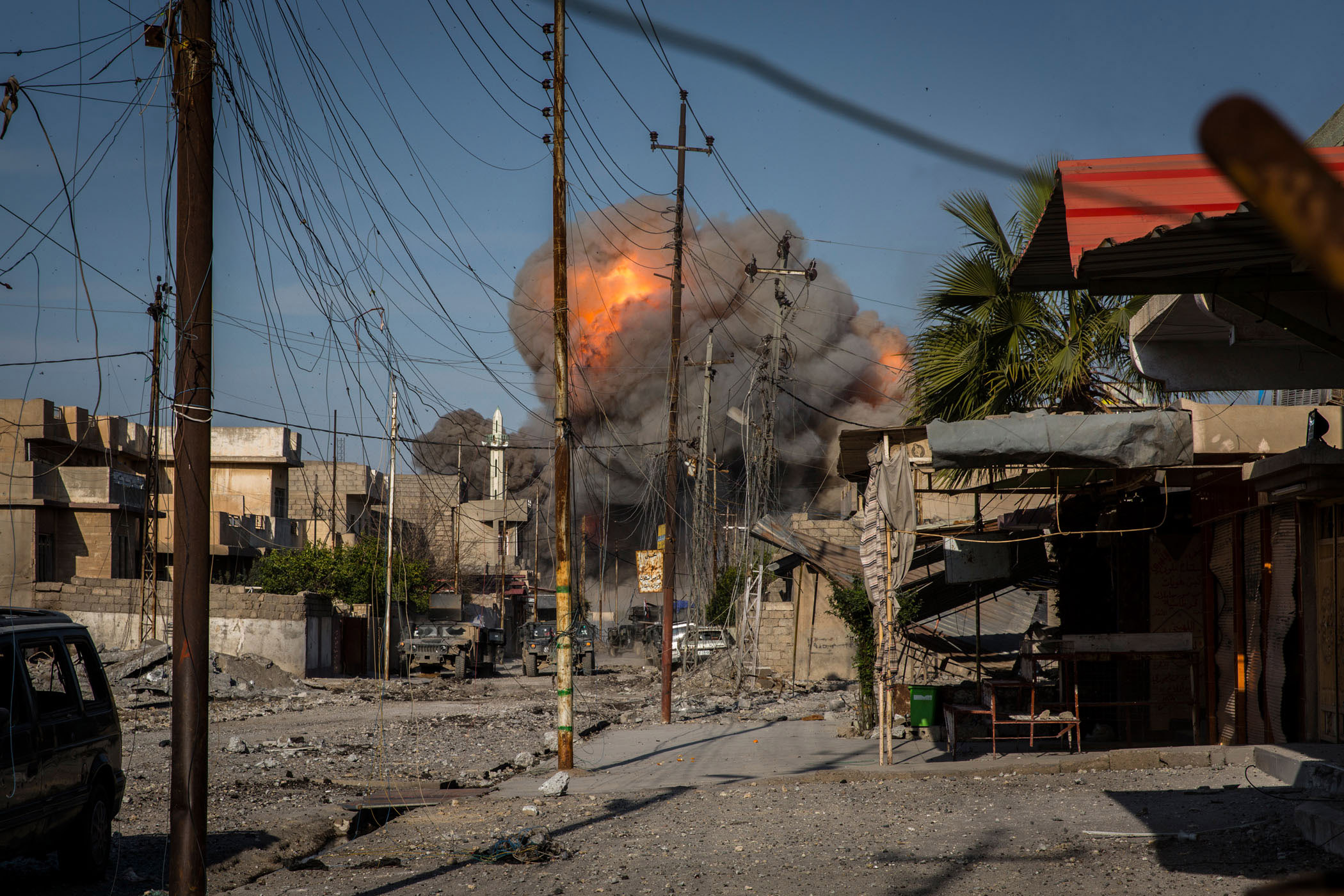
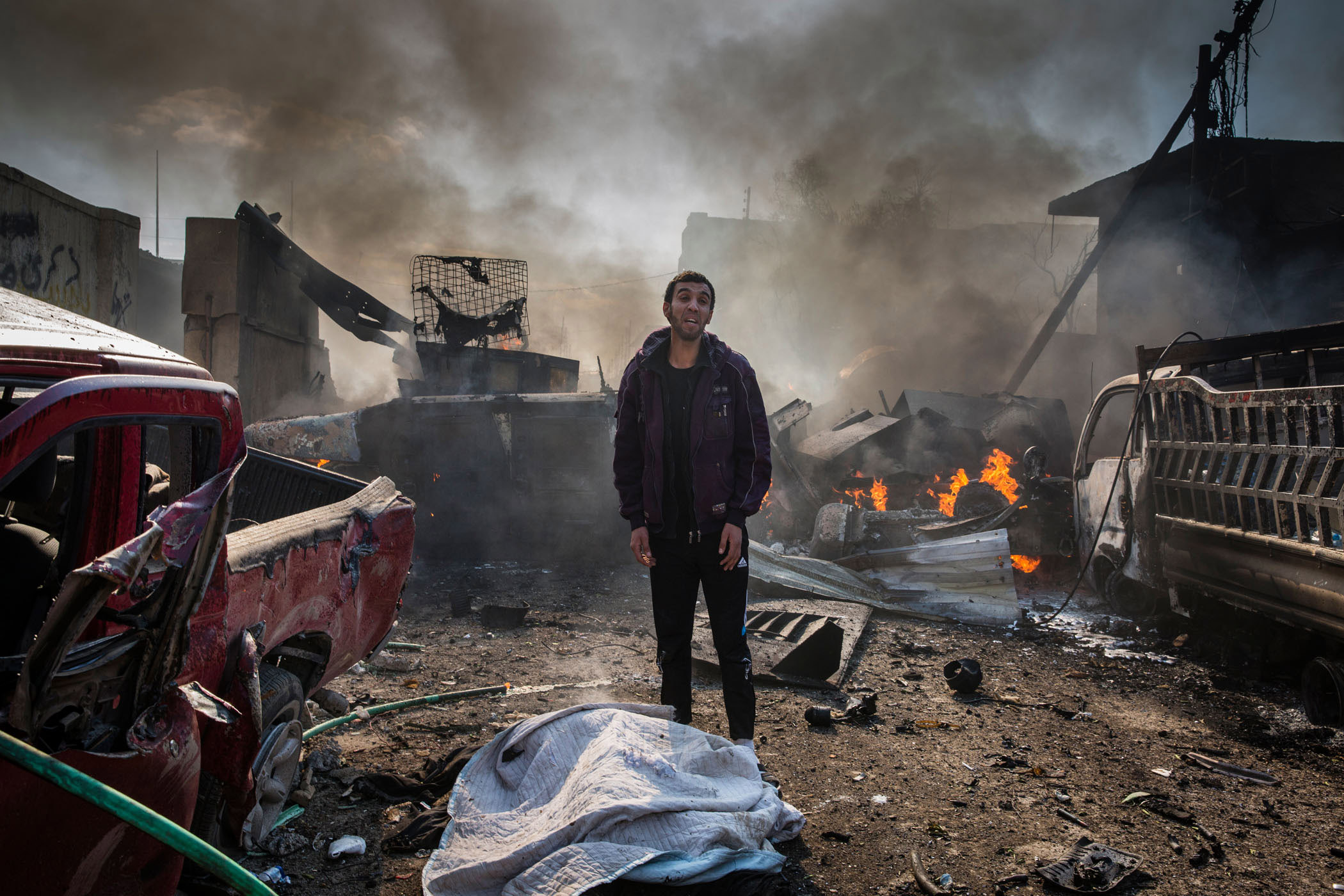
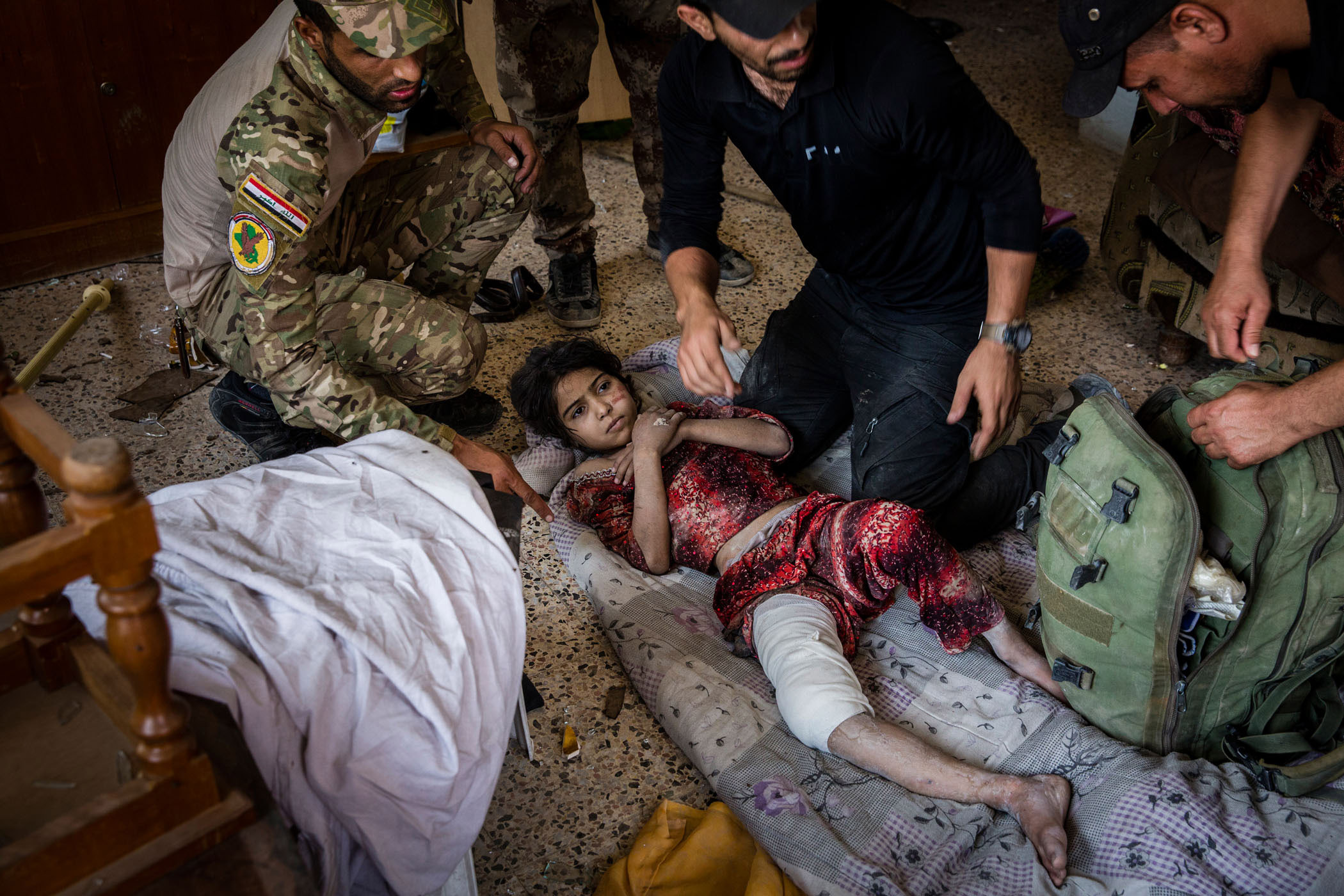
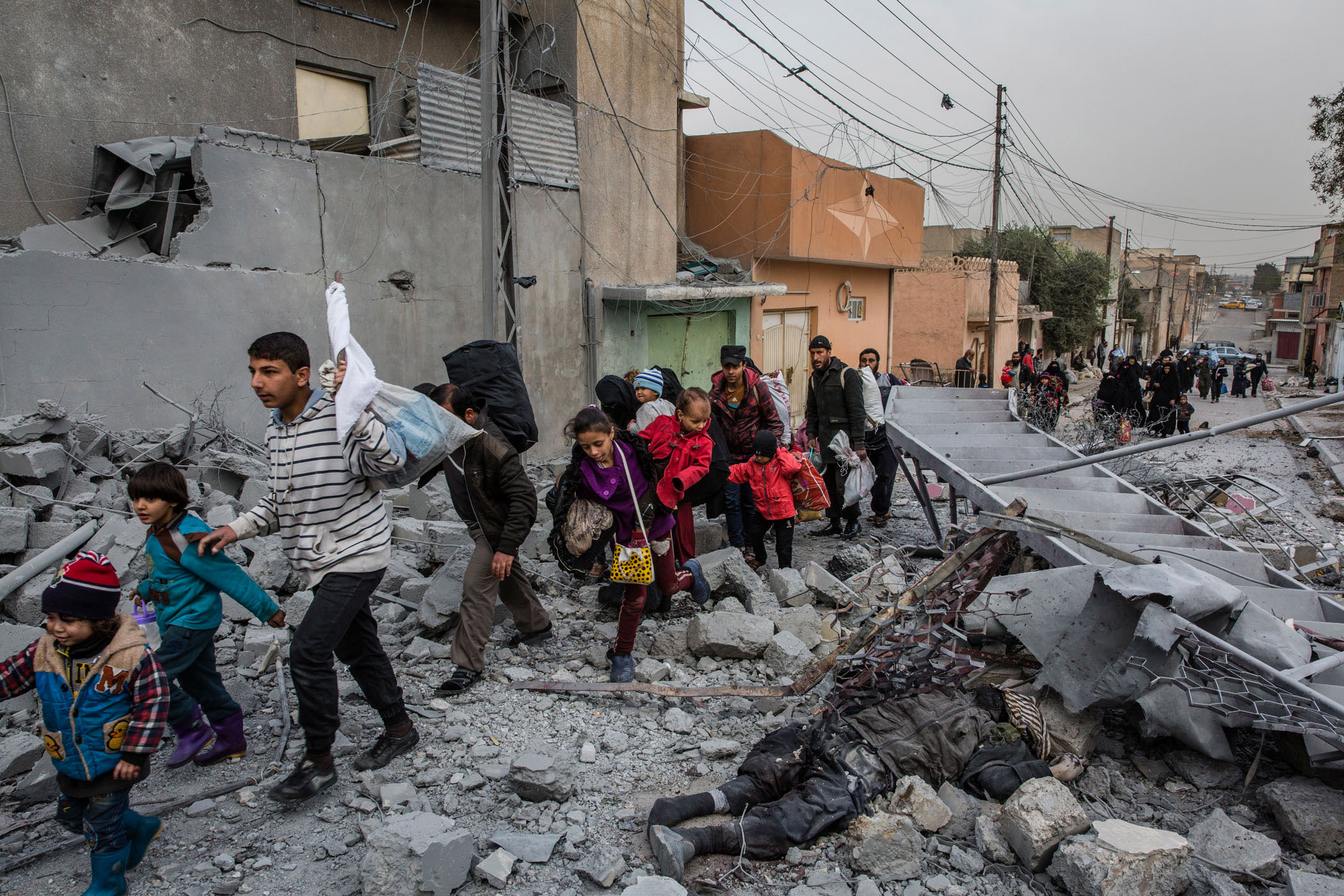
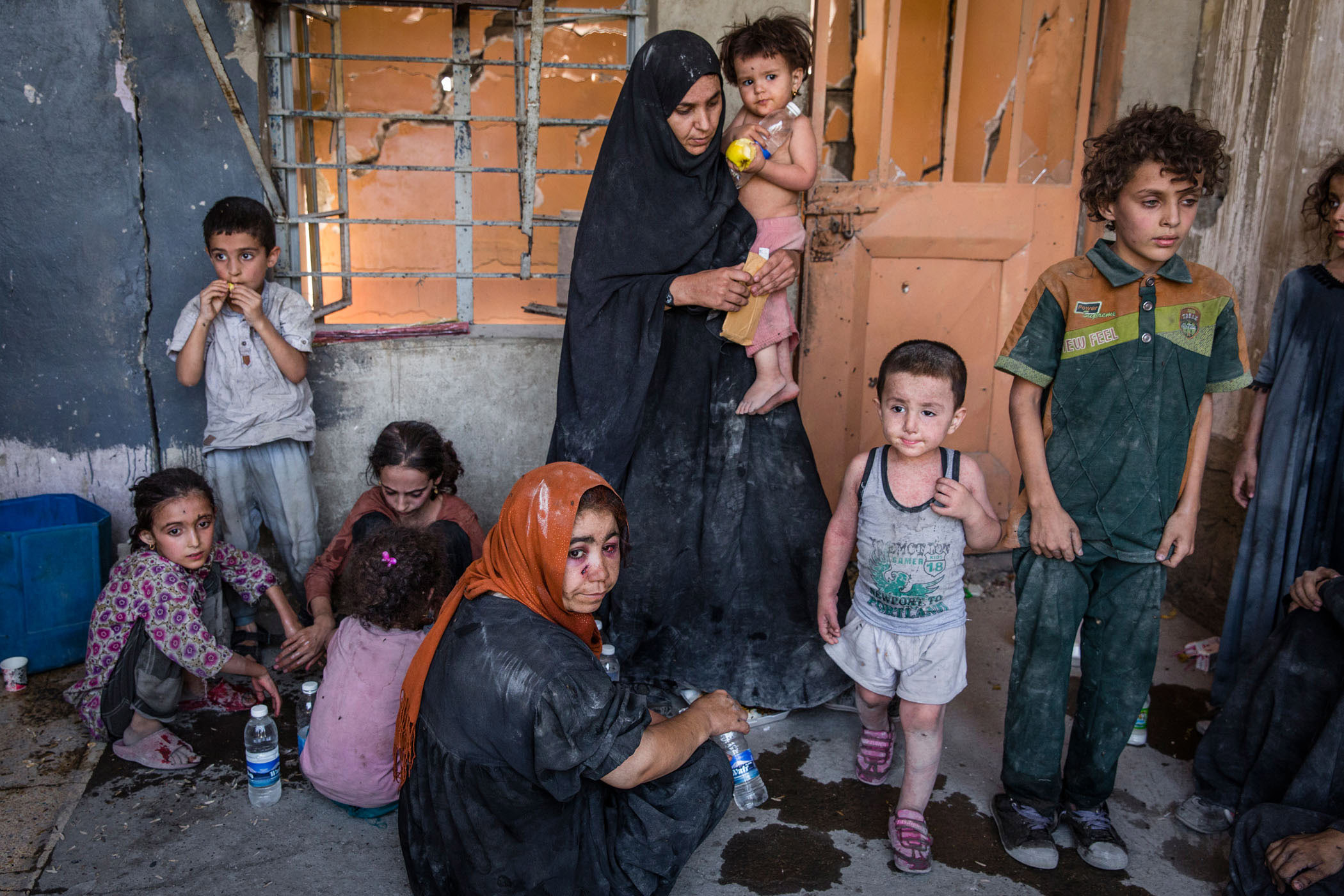
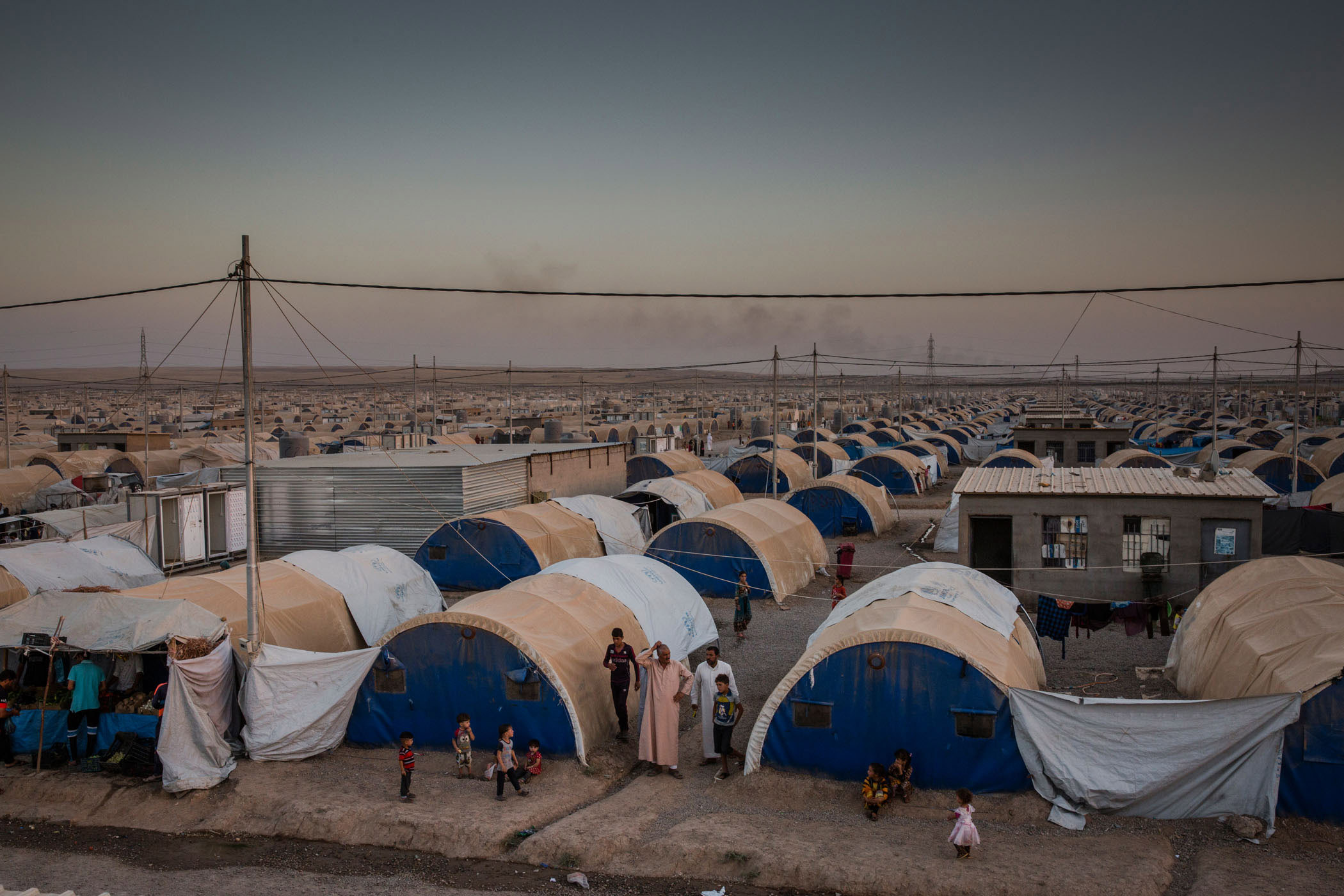
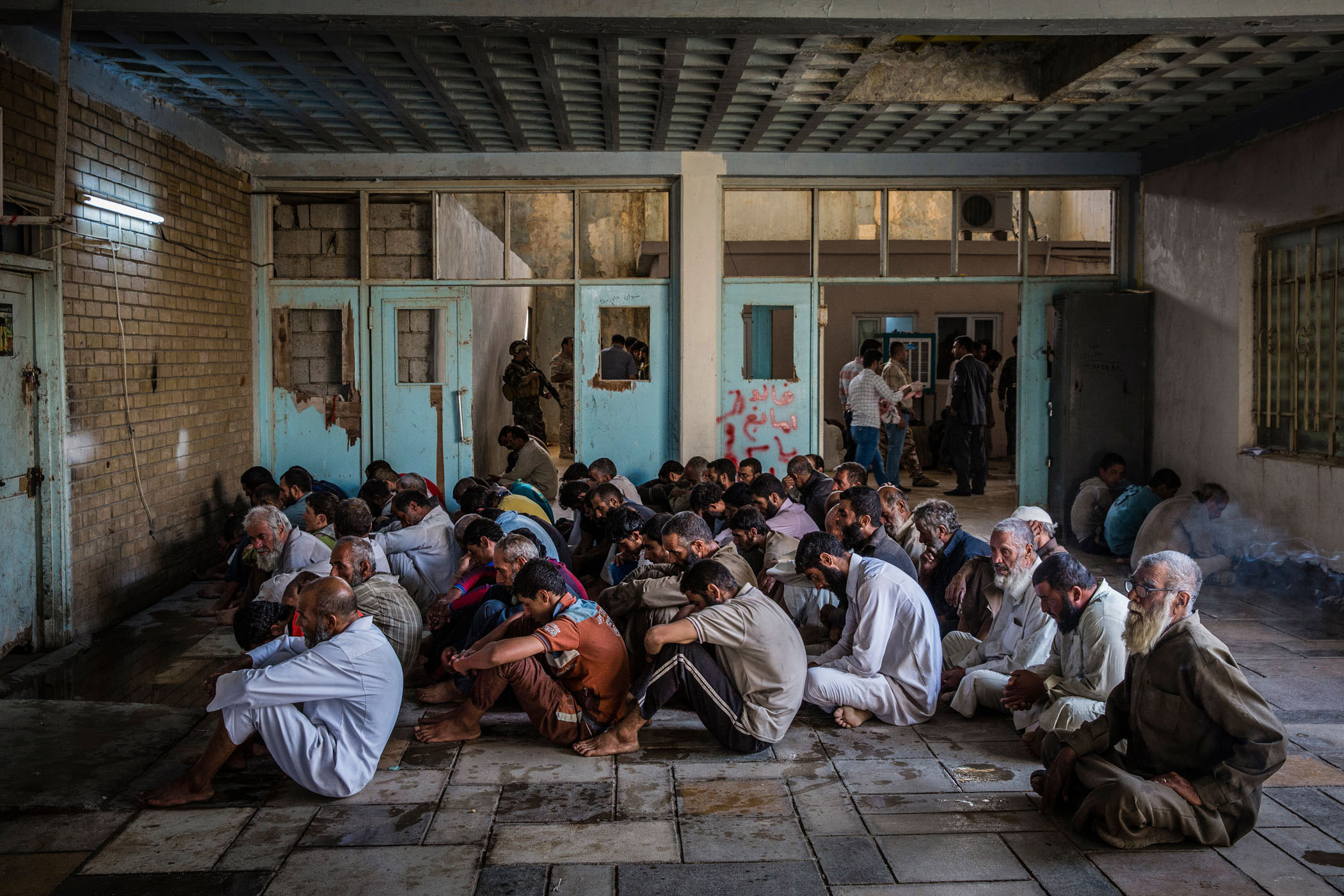
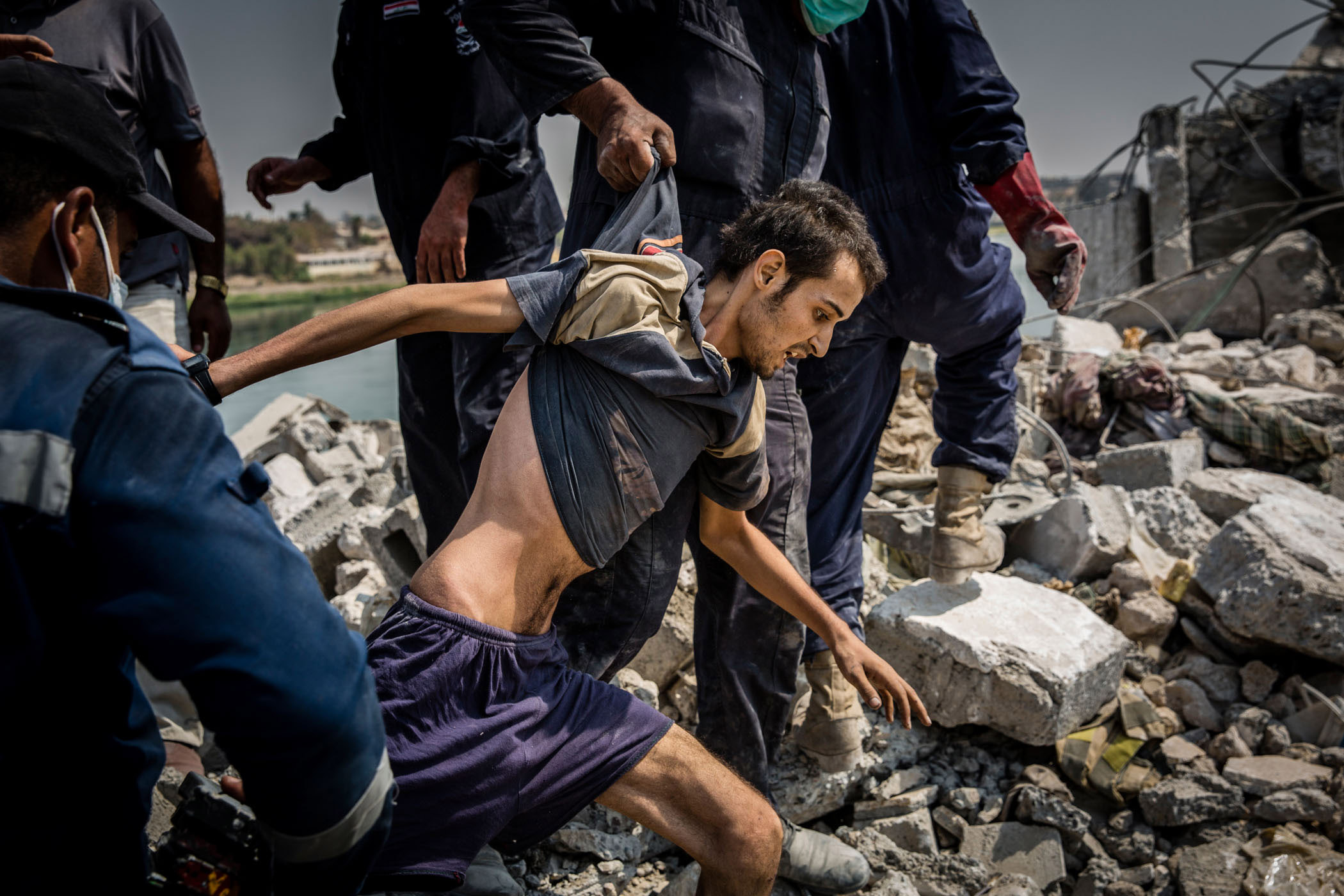
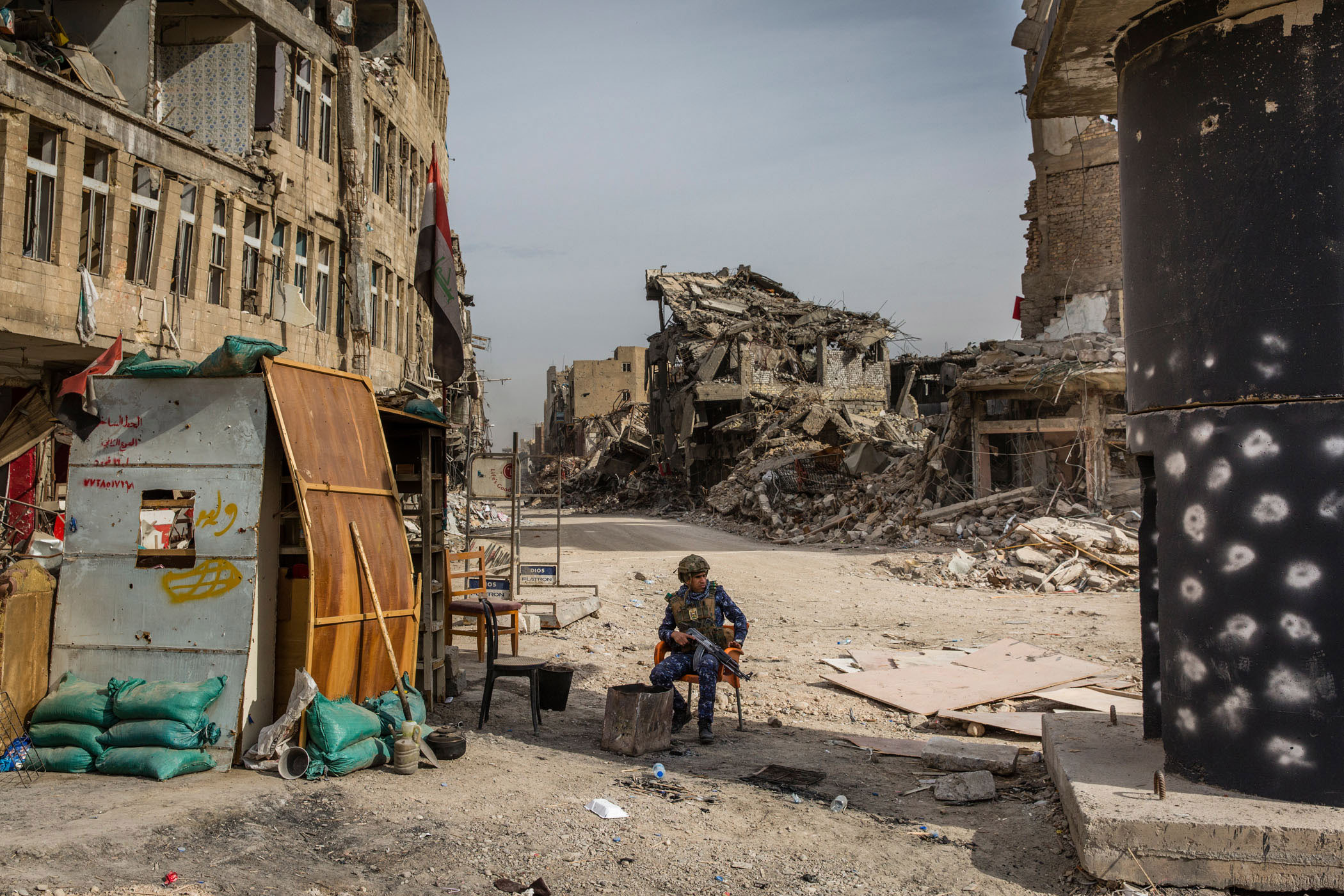
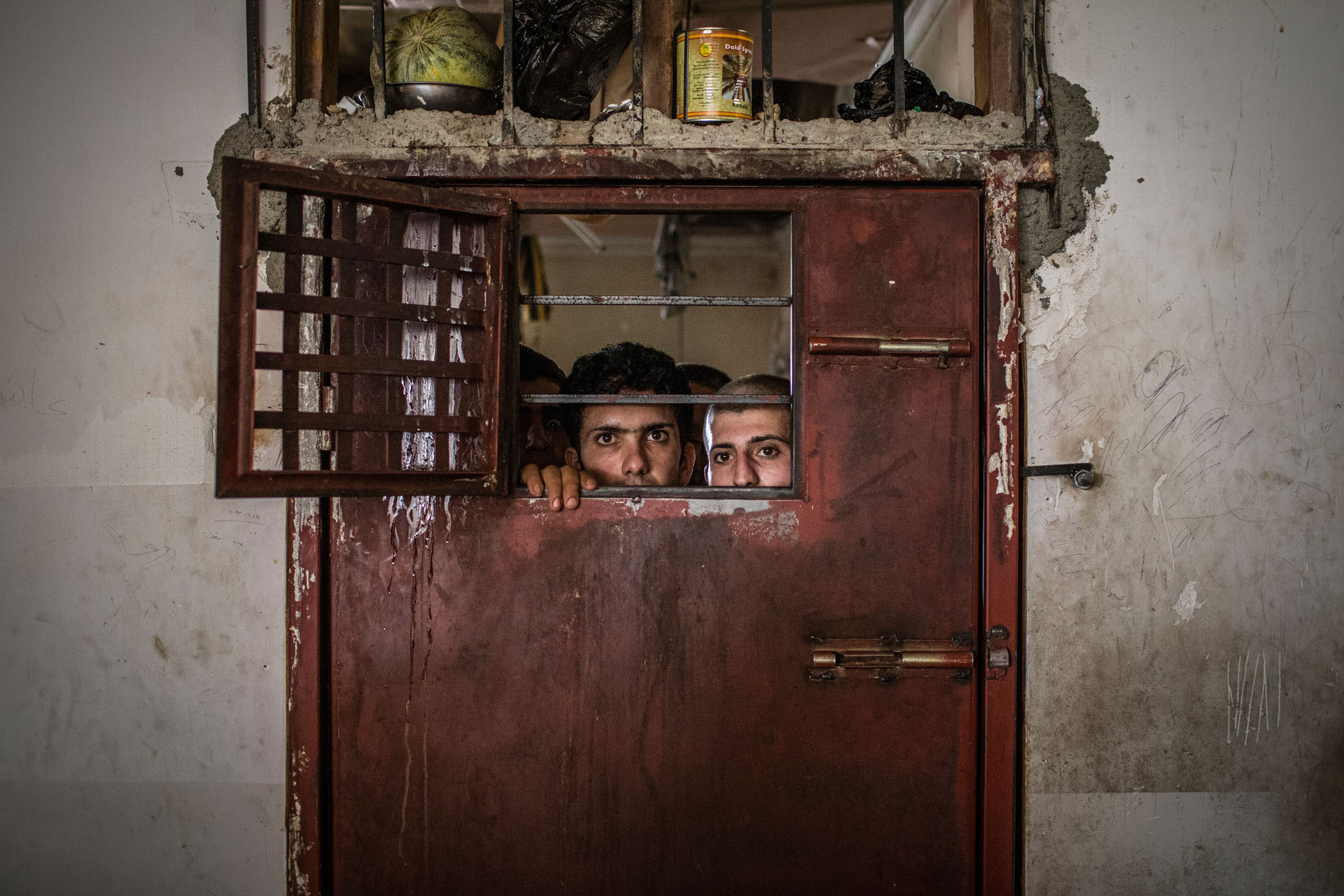
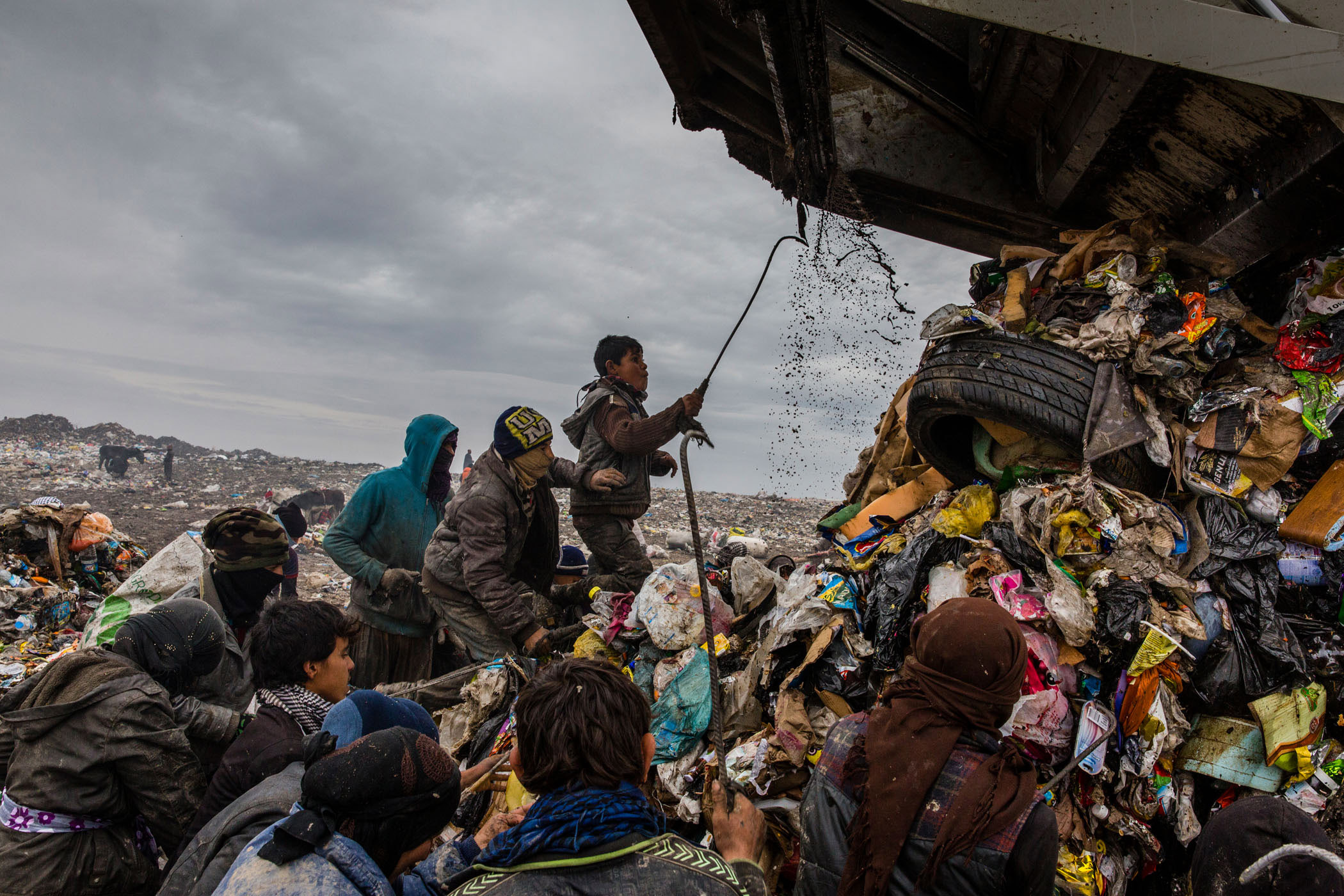
Scavengers, many of them young boys, foraged for scrap at Mosul’s main city dump. Since the city was liberated municipal services have struggled, apparently due to a lack of man power and machinery, much of which was either stolen or used during the fight for the city. Iraq- February 2018
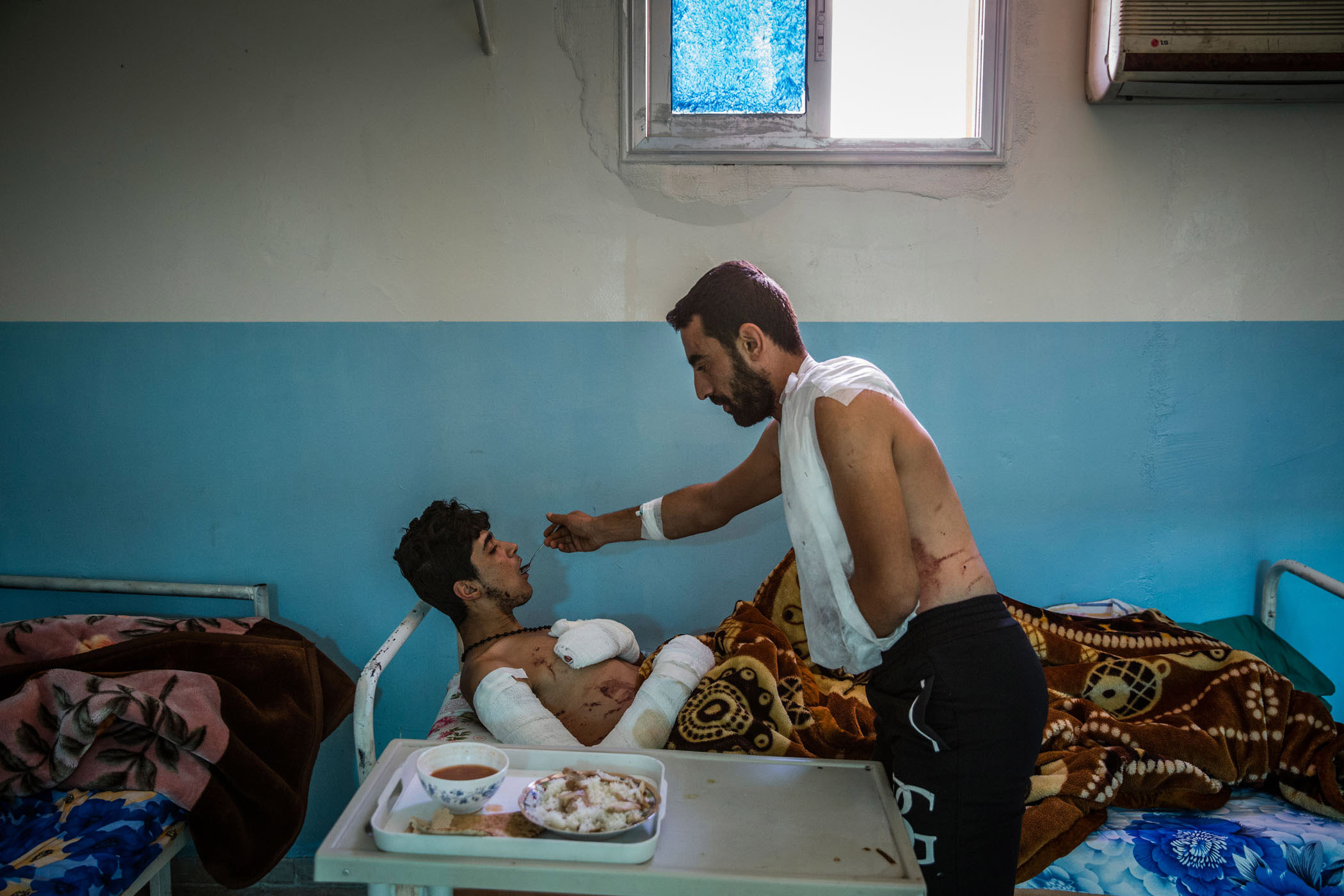
25-year-old Mohammed Sheko fed his SDF comrade, 18-year-old Salah Al Raqawi, at a hospital for injured fighters in Kurdish controlled Syria. The men were both injured in the previous week while fighting ISIS in Raqqa. Syria - Oct 2017
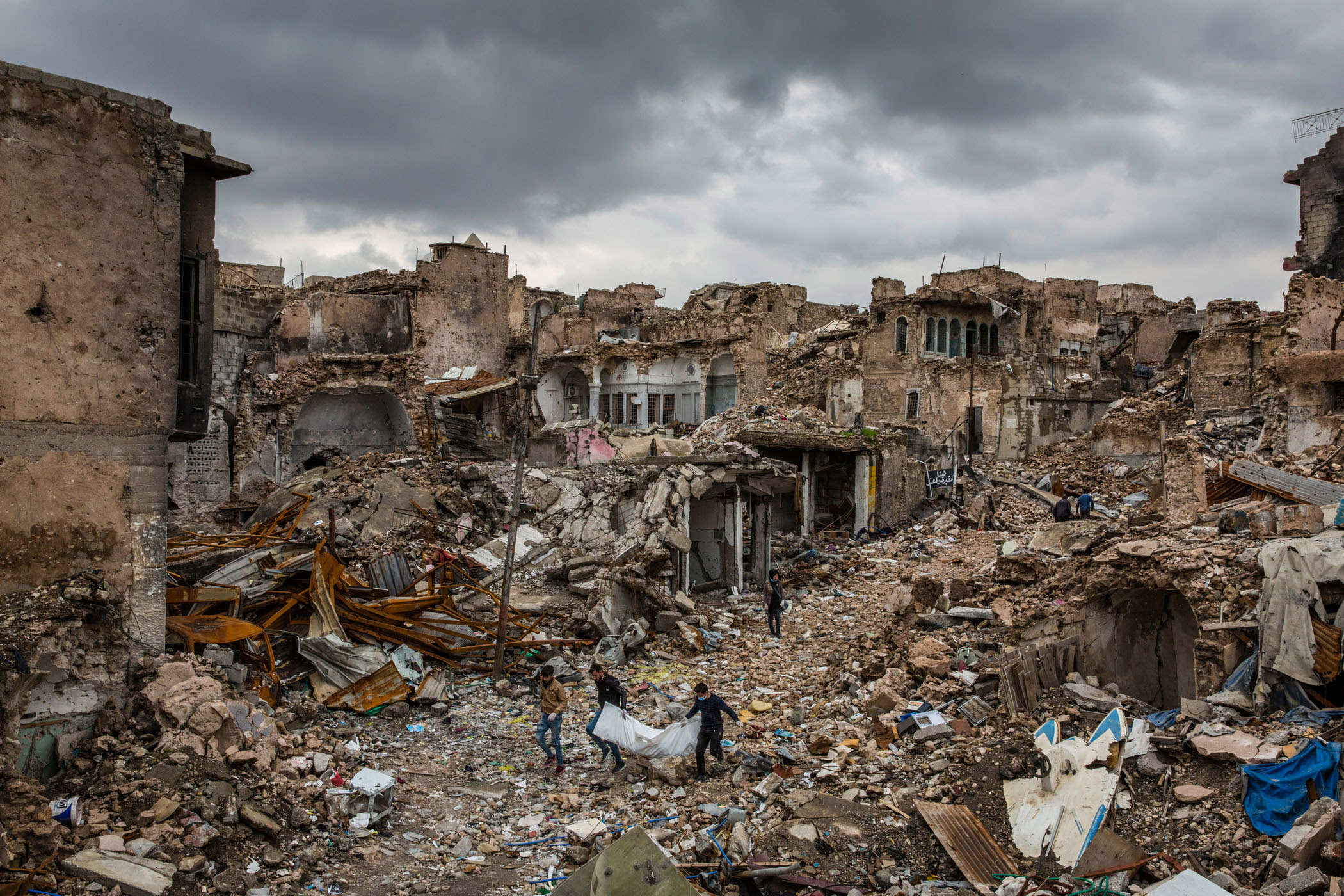
A group of volunteers worked to collect unclaimed bodies, most of them suspected of being those of ISIS members, from the ruins of the Old City district where the militants made their last stand. Iraq - February 2018
I was introduced to Mrs Rasoul * in the morning before we headed out in search of her relatives’ remains. I asked her consent to be present and photograph the process; she didn’t give it a second thought and said I was welcome to join. I immediately recognised and liked her tough demeanour.
Mrs Rasoul * sat in a plastic chair 15 feet from where an excavator was digging through the ruins of her home. At times she was engulfed in dust whipped up as the driver dumped mounds of stone and parts of her house beside her, but she refused to move. Slowly, they found the remains of both women.
Mrs Rasoul * directed the driver and shouted at the men on the ground to retrieve books and bags that she saw poking out of the debris. By the end of the day she was surrounded by a pile of tattered belongings that she wanted to bring with her. When the men said they were unable to bring all of the belongings with them she almost refused to leave.
* Mrs Rasoul is named as Mrs Aziz in End of the Caliphate, a book of Ivor’s work published by Steidl
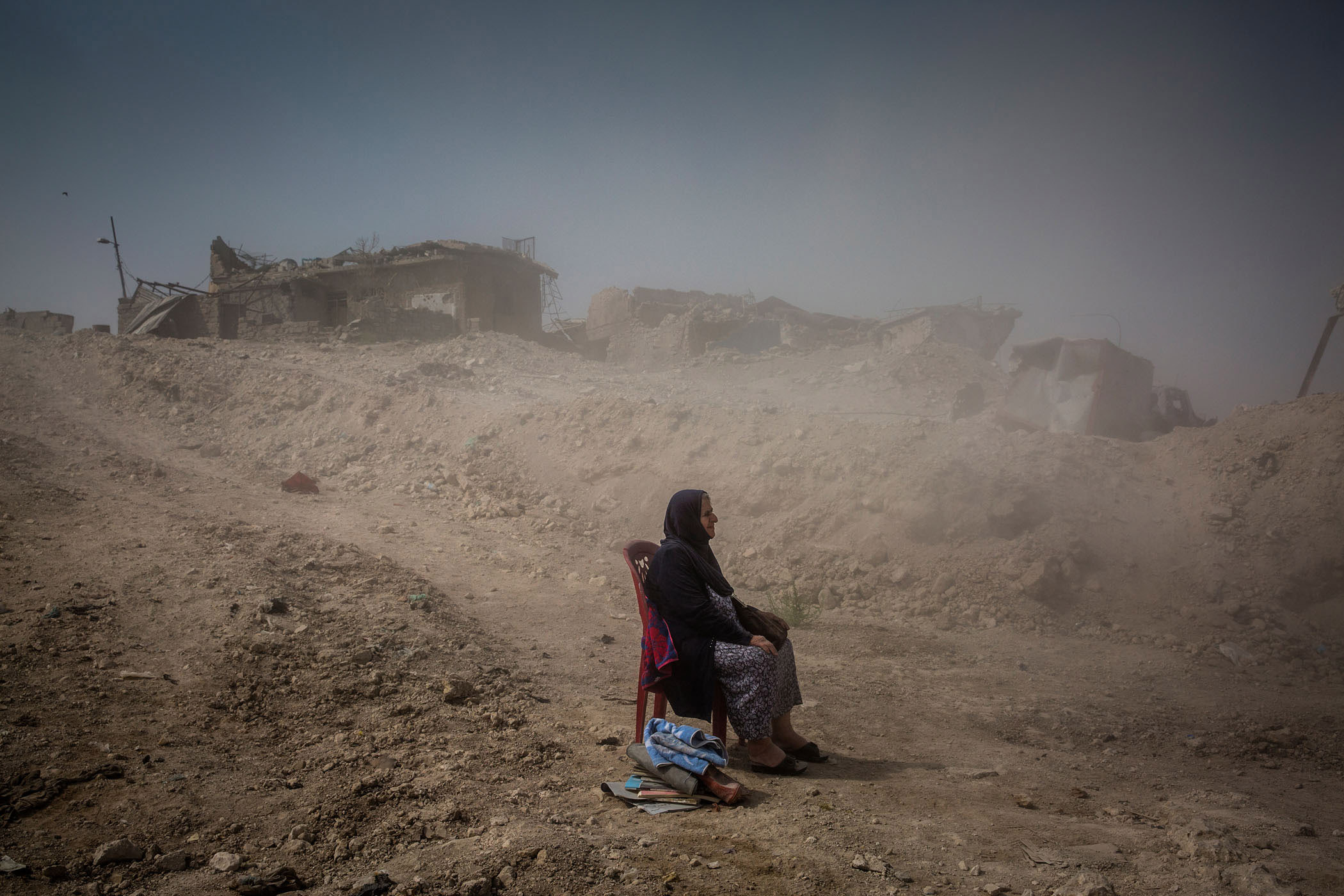
Nadhira Rasoul looked on as Iraqi Civil Defence workers dug out the bodies of her sister and niece from her house in the Old City of Mosul, where they were killed by an airstrike in June 2017. Iraq - September 2017
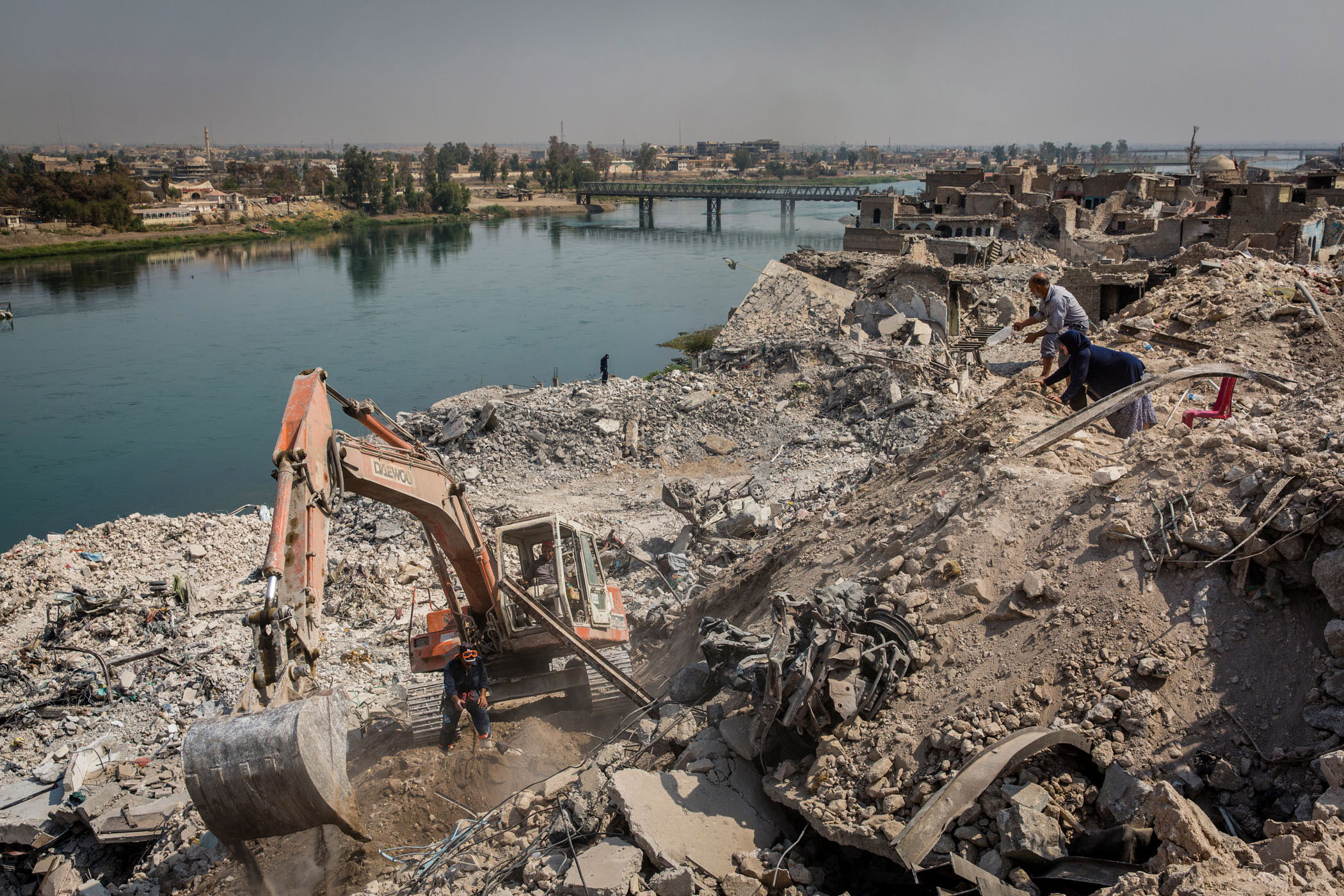
Iraqi civil defense workers began to look for the bodies of Sondus Mazaal’s mother and sister buried beneath the rubble while her aunt Nadhira Rasoul looked on and directed the crew from above. Iraq - September 2017
Watching Mrs Rasoul sit amidst the dust that day was simultaneously one of the most heart-breaking and inspiring things I have ever seen.
Her stoicism in the face of absolute loss was a deeply symbolic moment for me, one which said so much about the futility of war and the failure of intervention in Iraq, but at the same time was a testament to the depth of strength people have in this fractured region.
Although this moment came at the end of the more than nine-month long off ensive to take back Mosul, it encapsulated the tragedy of the latest cycle of violence to be played out in Iraq.
[The latest update I have received on Mrs Rasoul’s situation is that her house and neighbourhood still lie in ruins and that she has not received any compensation for the destruction of her property and the death of her family members.]
Despite the horror of the months of fighting in Mosul and the countless dead, it was impossible not to be affected by the signs of life that had returned to the city just less than a year later.
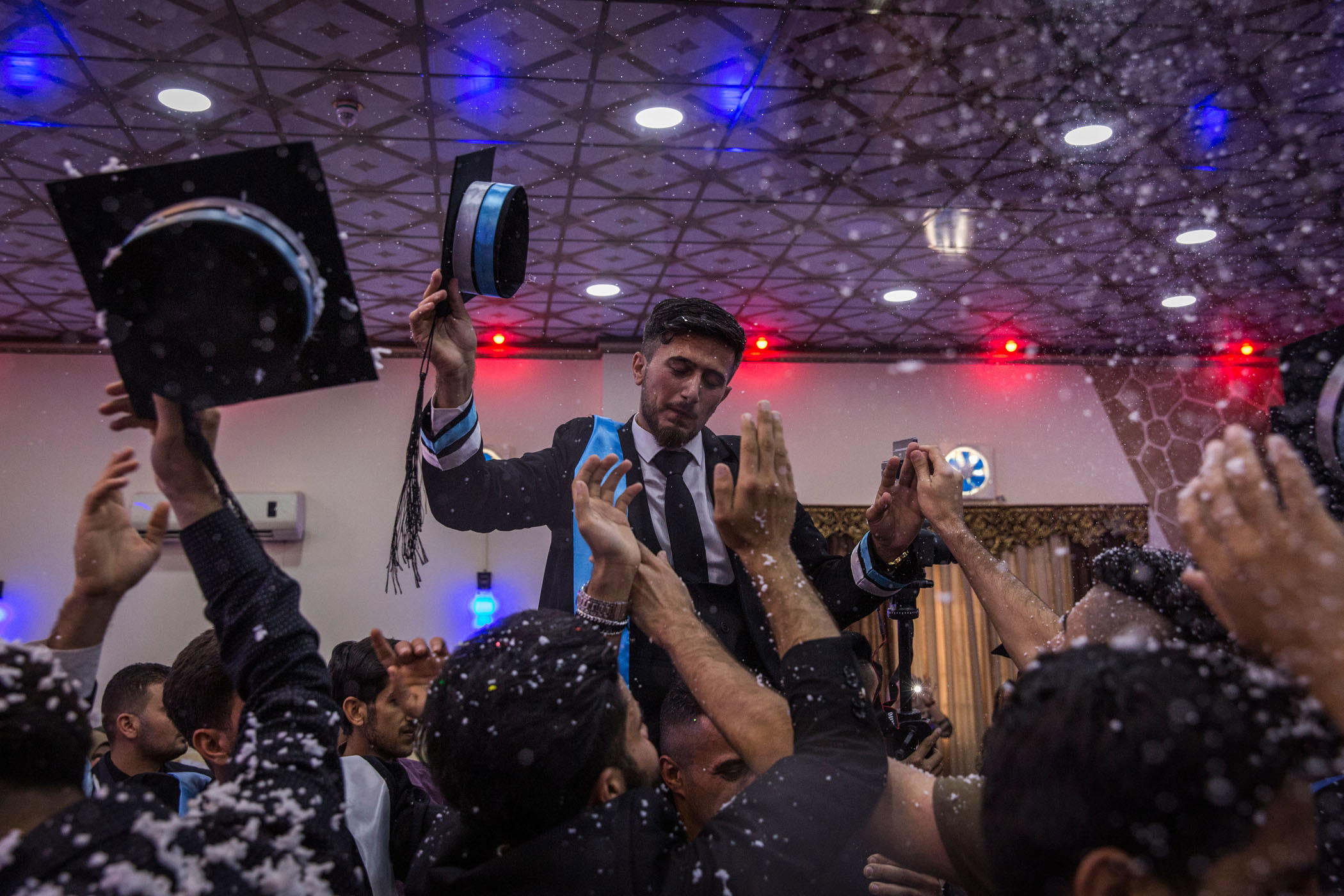
In May 2018, I found myself sitting in a bar in Mosul, on the banks of the Tigris, photographing people drinking alcohol and laughing. In the midst of the dark, smoky atmosphere, it was easy to forget what had passed here not so long before.
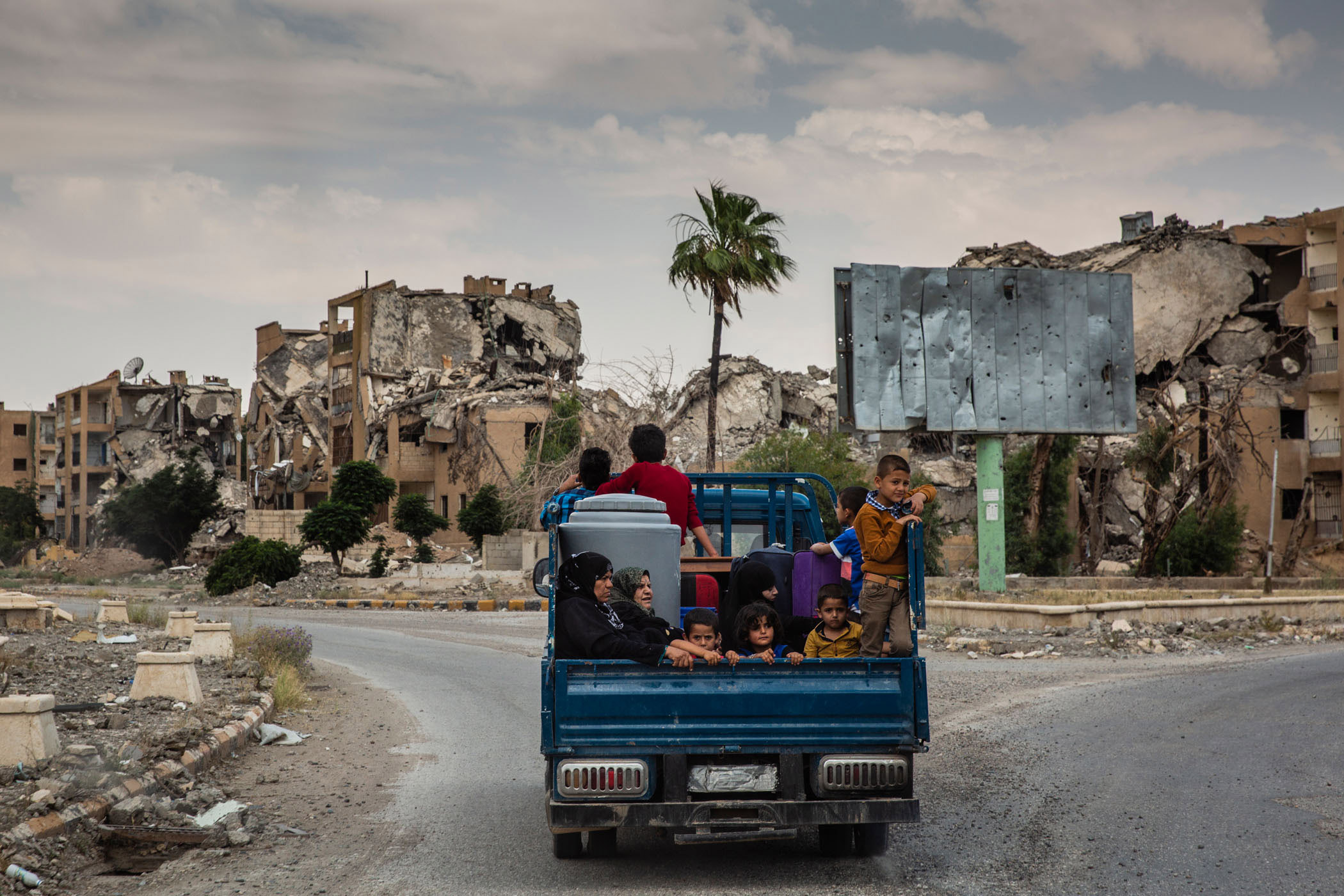
Eissa al-Ali and his family returned home to their heavily destroyed neighbourhood in Raqqa after years of being displaced. The battle to liberate the city from ISIS destroyed 80% of building and likely killed thousands of civilians. Syria - June 2018
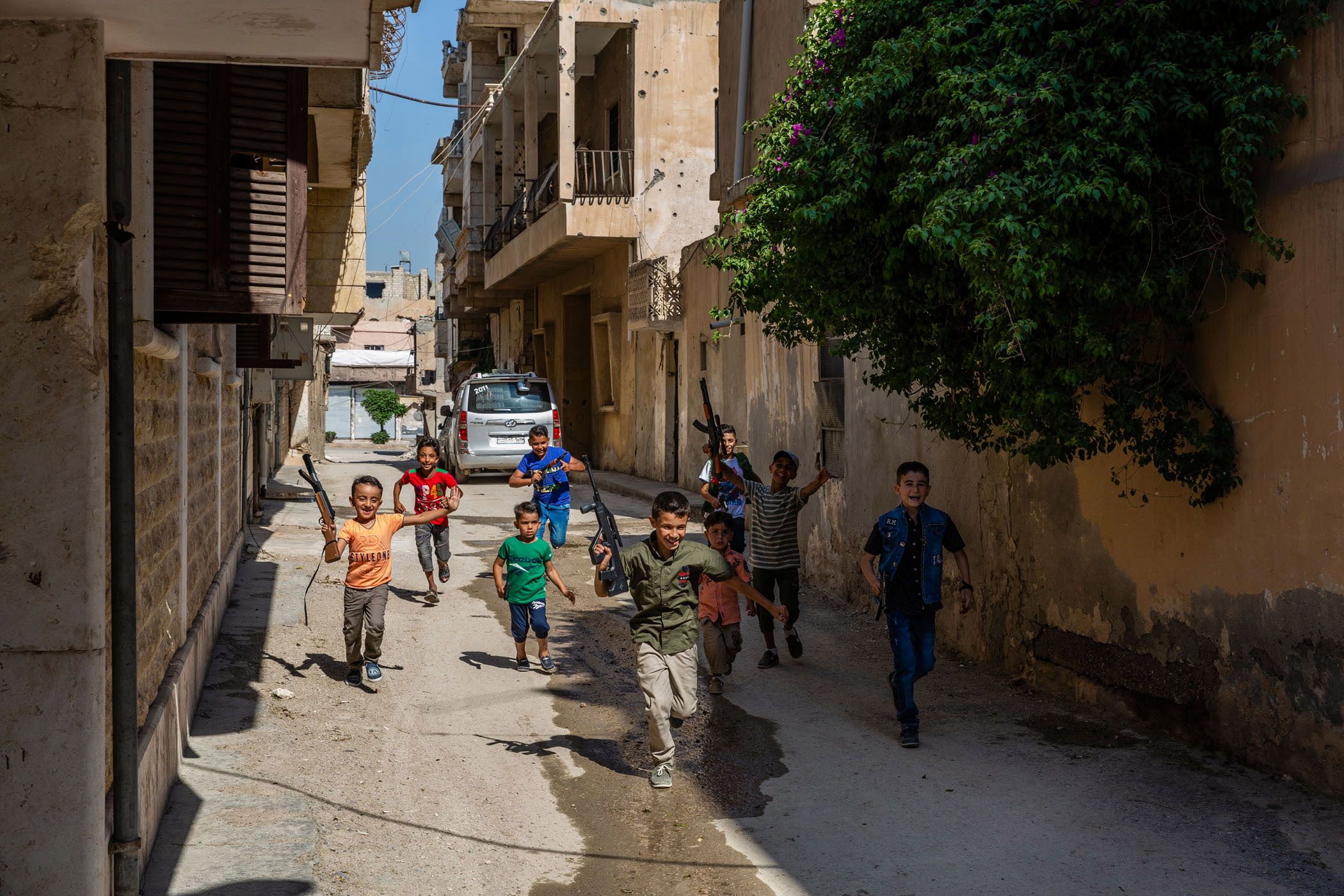
Young boys played mock war games with pellet guns on the first day of the Muslim holiday of Eid in Raqqa. Syria - June 2018
The young minds needed to rebuild a country so fractured and destroyed were coming back in force to attend classes at the prestigious University of Mosul, which was heavily damaged during the fighting. Some of the first students to graduate since the defeat of ISIS celebrated wildly at a reception hall.
With extended families in attendance, each graduate was paraded through the party under a shower of exploding glitter and booming Iraqi pop music. It was a touching moment to witness and one which gave me hope for the future of this majestic city.
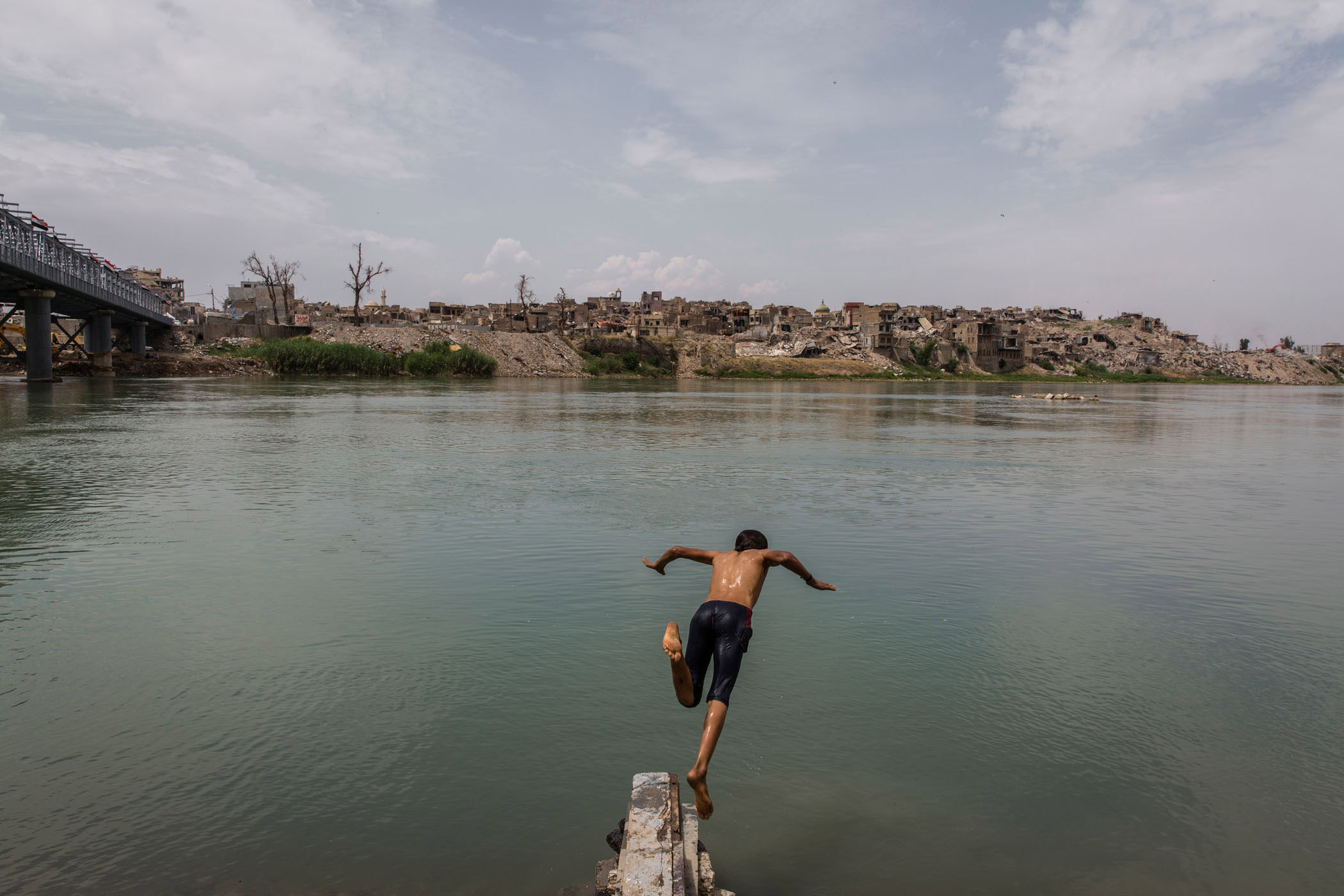
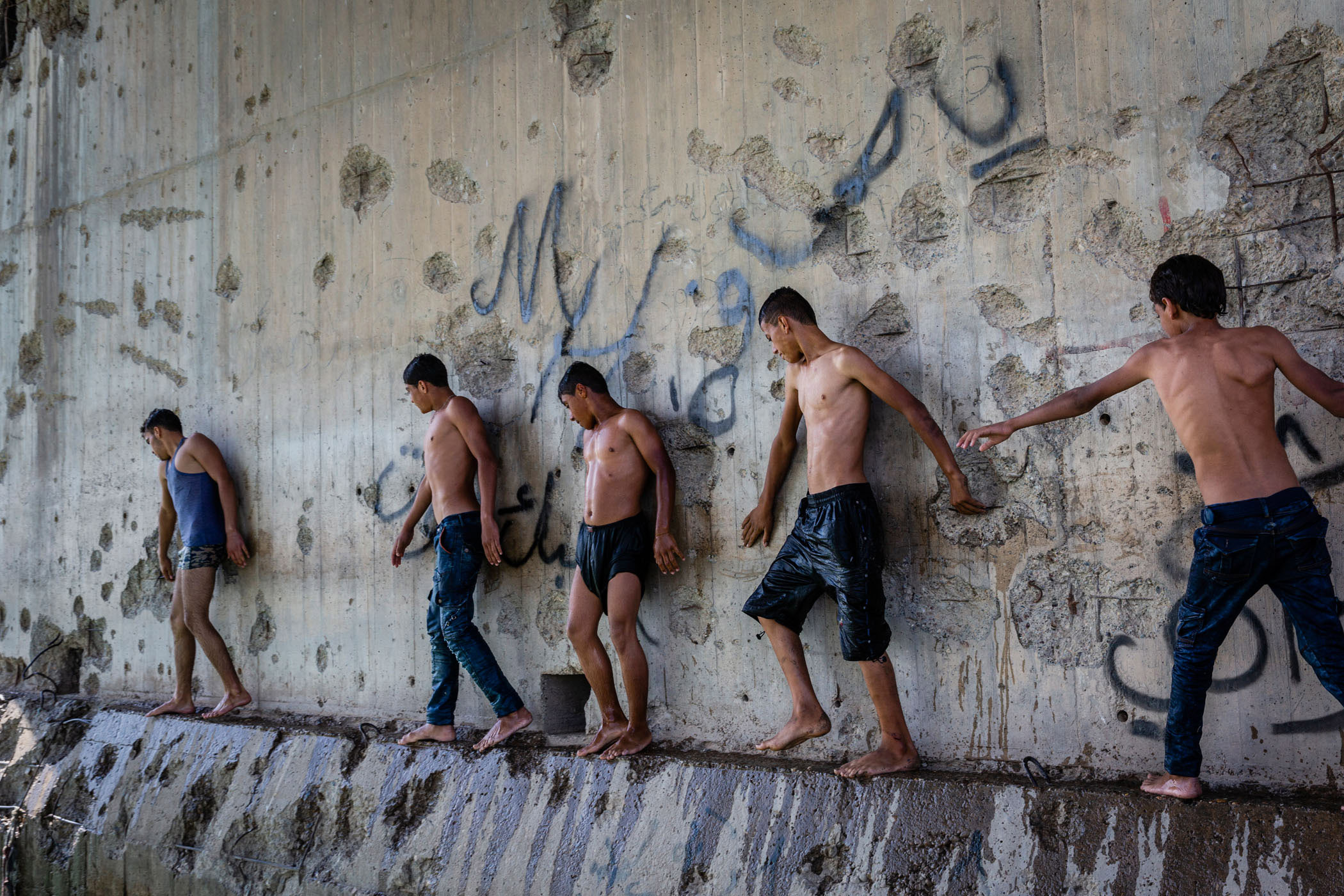
The power to move on and rebuild was once again prevalent but this time in the form of the young and educated – a new generation who were choosing to learn and equip themselves with knowledge as a weapon.
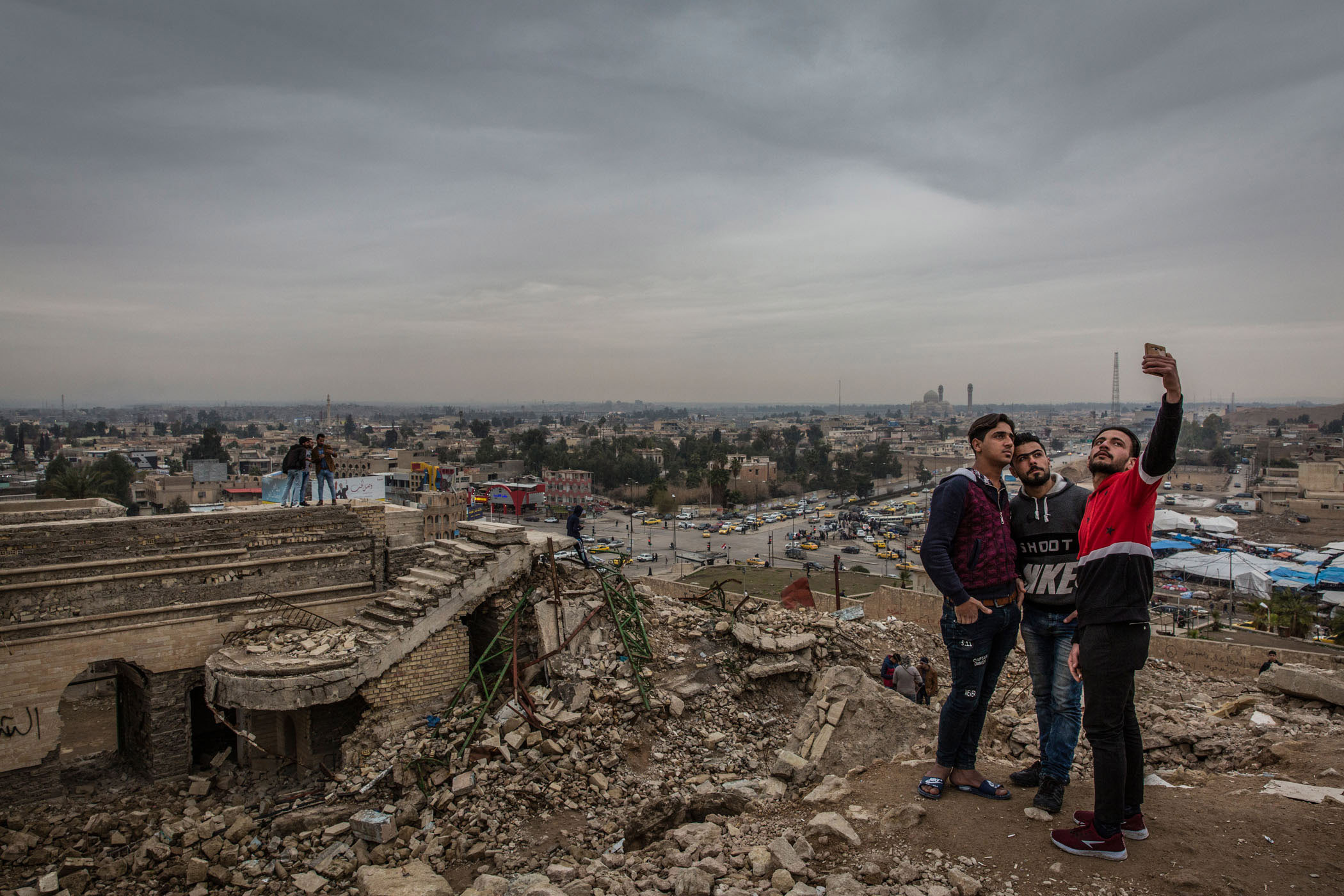
A much larger body of work encompassing Ivor’s extensive work in Iraq and Syria has been published by Steidl and is available to purchase here.
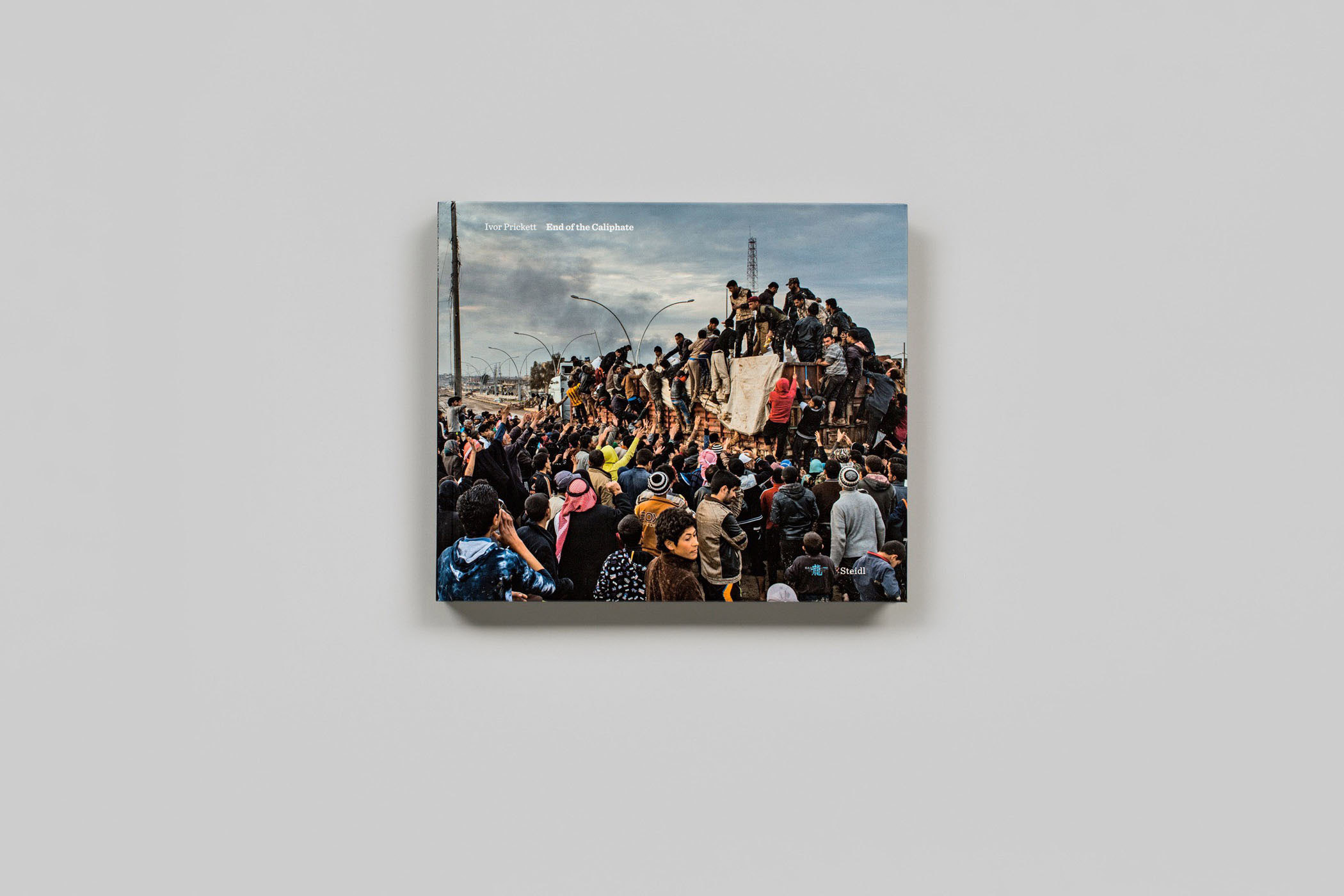
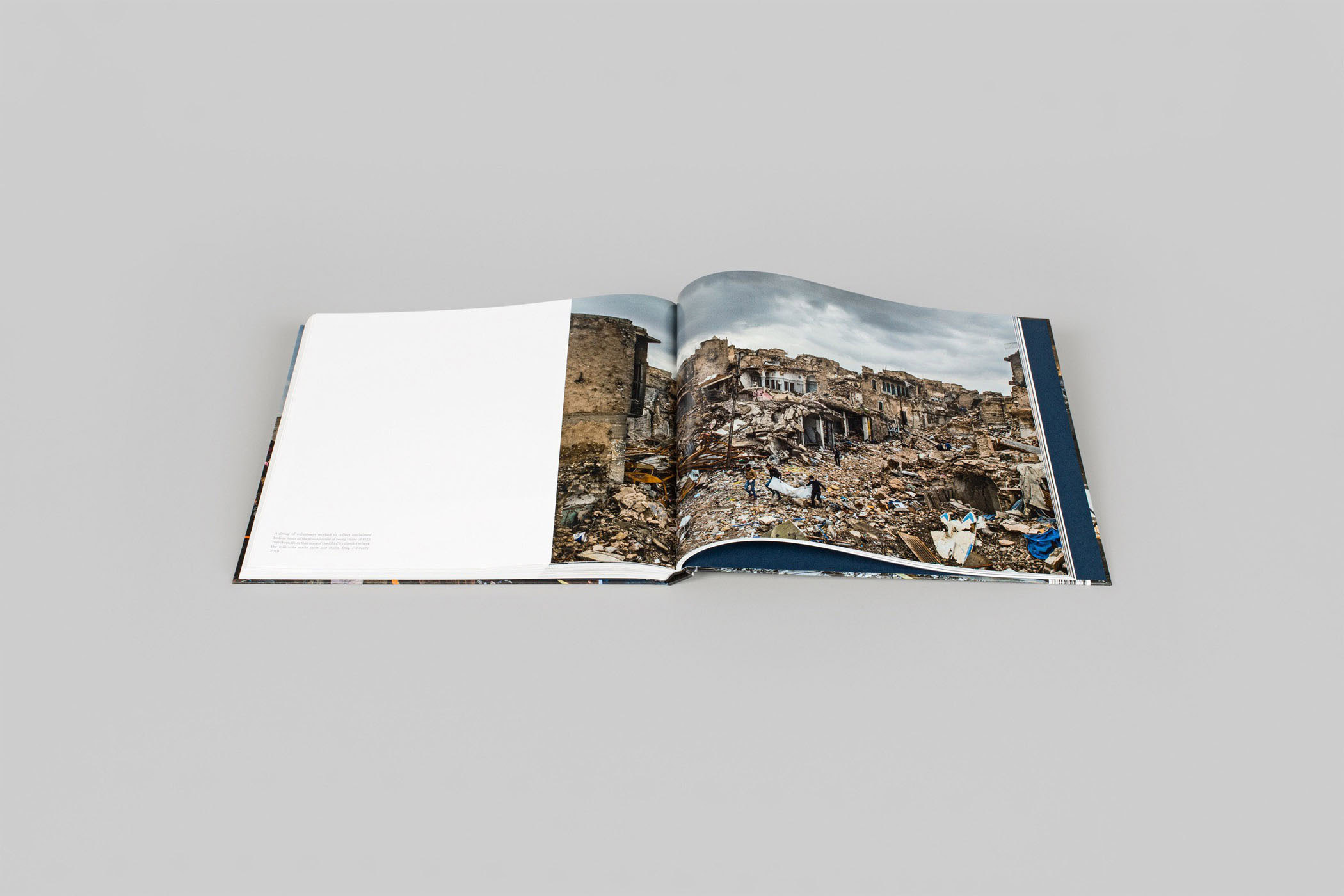
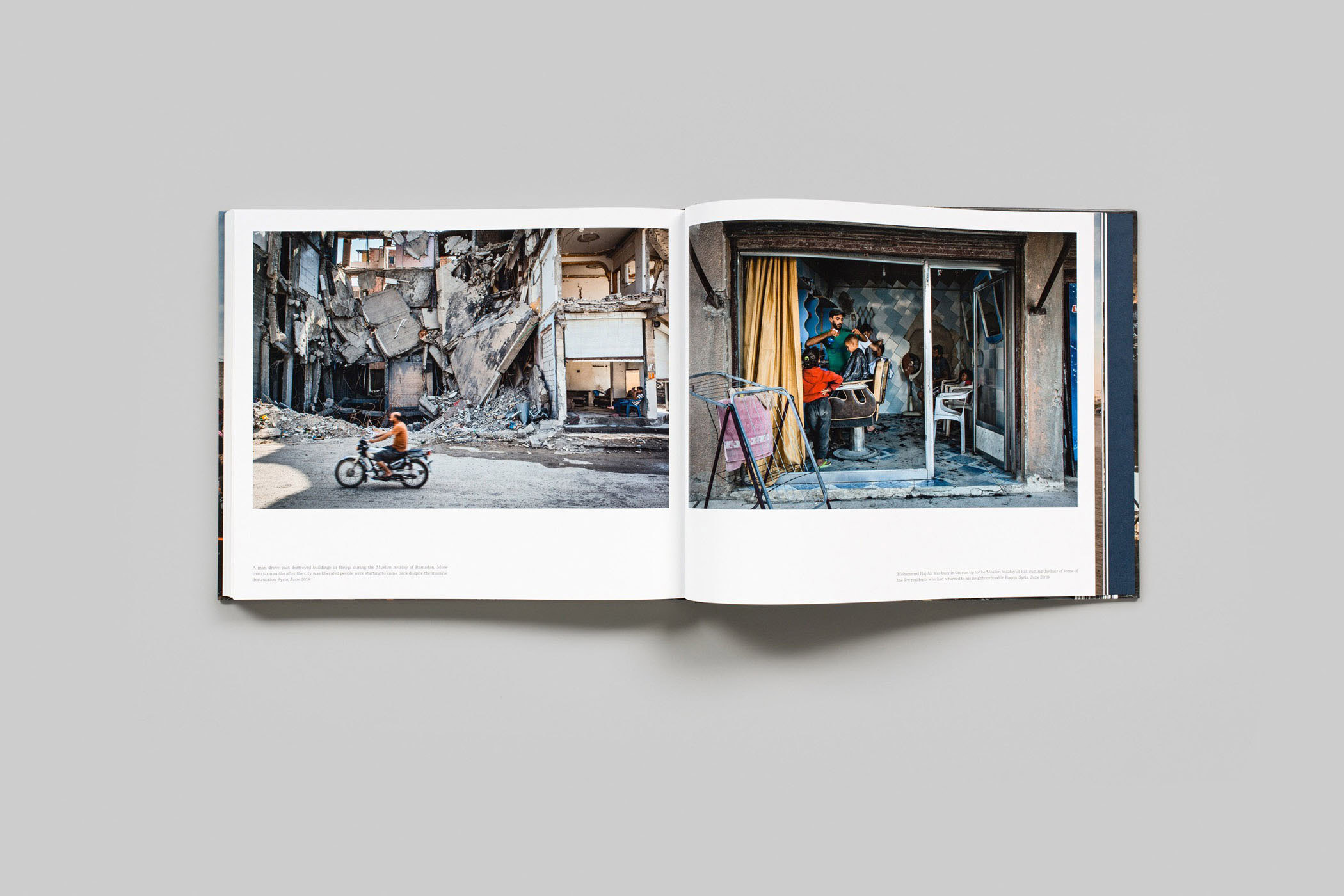
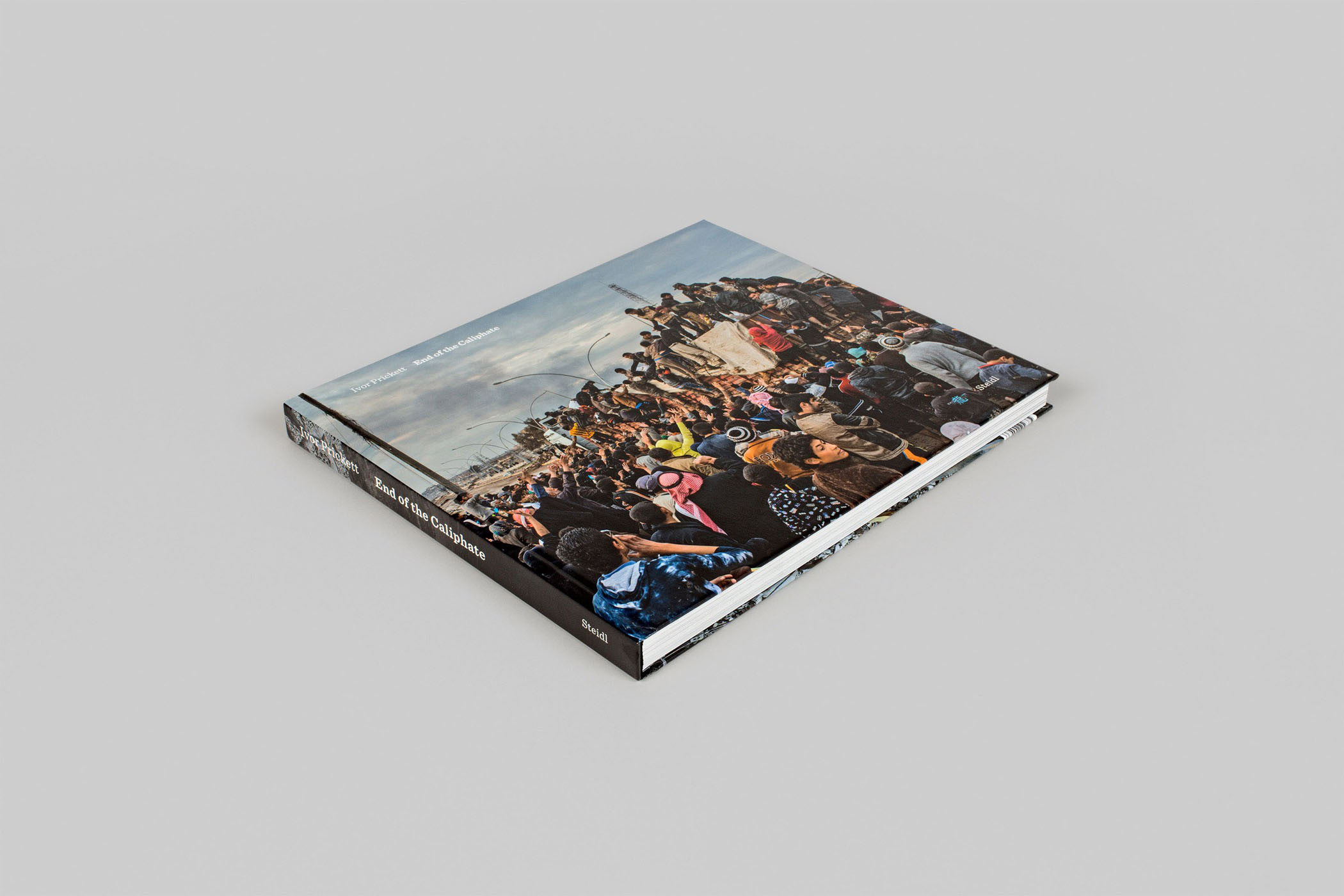
Ivor’s work will be exhibited at the annual Visa Pour l’Image photo festival in Perpignan, France, from 31 August to 15 September 2019.
Another exhibition of the award-winning work will take place at the Side Gallery in Newcastle-up-Tyne in the UK from 28 September until 15 December 2019.
The body of work has also been shortlisted for the prestigious Prix Pictet photo award.

